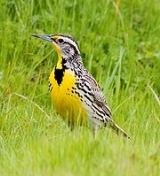
List of Oregon birds
Encyclopedia
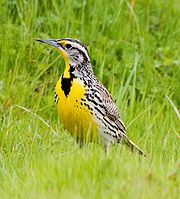
Bird
Birds are feathered, winged, bipedal, endothermic , egg-laying, vertebrate animals. Around 10,000 living species and 188 families makes them the most speciose class of tetrapod vertebrates. They inhabit ecosystems across the globe, from the Arctic to the Antarctic. Extant birds range in size from...
species found in the U.S. state
U.S. state
A U.S. state is any one of the 50 federated states of the United States of America that share sovereignty with the federal government. Because of this shared sovereignty, an American is a citizen both of the federal entity and of his or her state of domicile. Four states use the official title of...
of Oregon
Oregon
Oregon is a state in the Pacific Northwest region of the United States. It is located on the Pacific coast, with Washington to the north, California to the south, Nevada on the southeast and Idaho to the east. The Columbia and Snake rivers delineate much of Oregon's northern and eastern...
. There are between four and five hundred species regularly known to frequent the state, with another hundred or more that are occasionally or rarely seen.
Bird counts often change depending on factors such as the number and training of the observers, as well as opinions about what constitutes an officially recognized subspecies
Subspecies
Subspecies in biological classification, is either a taxonomic rank subordinate to species, ora taxonomic unit in that rank . A subspecies cannot be recognized in isolation: a species will either be recognized as having no subspecies at all or two or more, never just one...
. Though northern climes typically do not support as many species as southerly locations, Oregon is fifth in bird species diversity
Species diversity
Species diversity is an index that incorporates the number of species in an area and also their relative abundance. It is a more comprehensive value than species richness....
in the United States, behind Florida
Florida
Florida is a state in the southeastern United States, located on the nation's Atlantic and Gulf coasts. It is bordered to the west by the Gulf of Mexico, to the north by Alabama and Georgia and to the east by the Atlantic Ocean. With a population of 18,801,310 as measured by the 2010 census, it...
, New Mexico
New Mexico
New Mexico is a state located in the southwest and western regions of the United States. New Mexico is also usually considered one of the Mountain States. With a population density of 16 per square mile, New Mexico is the sixth-most sparsely inhabited U.S...
, Texas
Texas
Texas is the second largest U.S. state by both area and population, and the largest state by area in the contiguous United States.The name, based on the Caddo word "Tejas" meaning "friends" or "allies", was applied by the Spanish to the Caddo themselves and to the region of their settlement in...
, and California
California
California is a state located on the West Coast of the United States. It is by far the most populous U.S. state, and the third-largest by land area...
. This amount of diversity is attributable to Oregon's numerous distinctive ecoregions and relatively mild winter weather, which makes it an important wintering ground for migratory bird species, especially waterfowl
Waterfowl
Waterfowl are certain wildfowl of the order Anseriformes, especially members of the family Anatidae, which includes ducks, geese, and swans....
, on the Pacific Flyway
Pacific Flyway
The Pacific Flyway is a major north-south route of travel for migratory birds in America, extending from Alaska to Patagonia. Every year, migratory birds travel some or all of this distance both in spring and in fall, following food sources, heading to breeding grounds, or travelling to...
.
Another result of the state's varying ecology is the 120 Important Bird Area
Important Bird Area
An Important Bird Area is an area recognized as being globally important habitat for the conservation of bird populations. Currently there are about 10,000 IBAs worldwide. The program was developed and sites are identified by BirdLife International...
s (IBA), such as the Jackson Bottom Wetlands Preserve
Jackson Bottom Wetlands Preserve
Jackson Bottom Wetlands Preserve in Hillsboro, Oregon, United States, is a wetlands area along the Tualatin River in Washington County, Oregon...
, that are officially recognized as important conservation sites for birds. Many of these dedicated wildlife refuge
Wildlife refuge
A wildlife refuge, also called a wildlife sanctuary, may be a naturally occurring sanctuary, such as an island, that provides protection for species from hunting, predation or competition, or it may refer to a protected area, a geographic territory within which wildlife is protected...
s have become meccas for birding enthusiasts, and Oregon has participated in formally organized birding activities such as the Christmas Bird Count
Christmas Bird Count
The Christmas Bird Count is a census of birds in the Western Hemisphere, performed annually in the early Northern-hemisphere winter by volunteer birders...
since the early 1900s.
As an important U.S. region of bird diversity, Oregon has faced some serious challenges in protecting endangered and threatened avian species. In addition to high profile, threatened species such as the Northern Spotted Owl
Northern Spotted Owl
The Northern Spotted Owl, Strix occidentalis caurina, is one of three Spotted Owl subspecies. A Western North American bird in the family Strigidae, genus Strix, it is a medium-sized dark brown owl sixteen to nineteen inches in length and one to one and one sixth pounds. Females are larger than males...
and Snowy Plover
Snowy Plover
The Snowy Plover is a small wader in the plover bird family. It breeds in Ecuador, Peru, Chile, the southern and western USA and the Caribbean...
, even many common species—including Oregon's state bird, the Western Meadowlark
Western Meadowlark
Not to be confused with Eastern MeadowlarkThe Western Meadowlark is a medium-sized icterid bird, about 8.5 in long. It nests on the ground in open country in western and central North America. It feeds mostly on insects, but also seeds and berries...
—have declined considerably due to hunting, habitat loss, and other factors.
| Table of contents |
|---|
| Anseriformes • Galliformes • Gaviiformes • Podicipediformes • Procellariiformes • Ciconiiformes • Falconiformes • Gruiformes • Charadriiformes • Columbiformes • Cuculiformes • Strigiformes • Caprimulgiformes • Apodiformes • Coraciiformes • Piciformes • Passeriformes |
| See also References External links |
Order AnseriformesAnseriformesThe order Anseriformes contains about 150 living species of birds in three extant families: the Anhimidae , Anseranatidae , and the Anatidae, which includes over 140 species of waterfowl, among them the ducks, geese, and swans.All species in the order are highly adapted for an aquatic existence at...
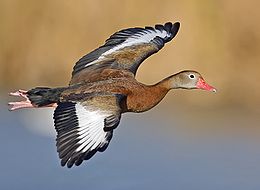


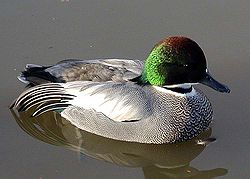
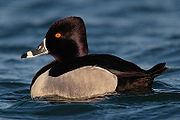
Family AnatidaeAnatidaeAnatidae is the biological family of birds that includes ducks, geese and swans. The family has a cosmopolitan distribution, occurring on all the world's continents except Antarctica and on most of the world's islands and island groups...
Subfamily DendrocygninaeDendrocygninae
The whistling ducks or tree ducks are a subfamily, Dendrocygninae of the duck, goose and swan family of birds, Anatidae. In other taxonomical approaches, they are either considered a separate family "Dendrocygnidae", or a tribe "Dendrocygnini" in the goose subfamily Anserinae The whistling ducks or...
- Black-bellied Whistling DuckBlack-bellied Whistling DuckThe Black-bellied Whistling Duck , formerly also called Black-bellied Tree Duck, is a whistling duck that breeds from the southernmost United States and tropical Central to south-central South America. In the USA, it can be found year-round in parts of southeast Texas, and seasonally in southeast...
Dendrocygna autumnalis - Fulvous Whistling DuckFulvous Whistling DuckThe Fulvous Whistling Duck, Dendrocygna bicolor, is a whistling duck which breeds across the world's tropical regions in much of Central and South America, Sub-Saharan Africa, the Indian subcontinent, and the Gulf Coast of the United States....
Dendrocygna bicolor
Subfamily Anserinae
Anserinae
The Anserinae is a subfamily in the waterfowl family Anatidae. It includes the swans and true geese. Under alternative systematical concepts , it is split into two subfamilies, the Anserinae containing the geese , while the Cygninae contain the swans.A number of other waterbirds, mainly related to...
- Emperor GooseEmperor GooseThe Emperor Goose is a species of goose. It breeds around the Bering Sea, mostly in Alaska, USA, but also in Kamchatka, Russia...
Chen canagica - Snow GooseSnow GooseThe Snow Goose , also known as the Blue Goose, is a North American species of goose. Its name derives from the typically white plumage. The genus of this bird is disputed...
Chen caerulescens - Ross's GooseRoss's GooseThe Ross's Goose is a North American species of goose.The American Ornithologists' Union places this species and the other two "white" geese in the genus Chen rather than the more traditional "grey" goose genus Anser.This goose breeds in northern Canada, mainly in the Queen Maud Gulf Migratory...
Chen rossii - Brent GooseBrent GooseThe Brant or Brent Goose, Branta bernicla, is a species of goose of the genus Branta. The Black Brant is an American subspecies. The specific descriptor bernicla is from the same source as "barnacle" in Barnacle Goose, which looks similar but is not a close relation.-Appearance:The Brant Goose is...
Branta bernicla - Cackling GooseCackling GooseThe Cackling Goose is a North American bird of the genus Branta of black geese, which contains species with largely black plumage, distinguishing them from the grey Anser species....
Branta hutchinsii - Canada GooseCanada GooseThe Canada Goose is a wild goose belonging to the genus Branta, which is native to arctic and temperate regions of North America, having a black head and neck, white patches on the face, and a brownish-gray body....
Branta canadensis - Trumpeter SwanTrumpeter SwanThe Trumpeter Swan, Cygnus buccinator, is the largest native North American bird, if measured in terms of weight and length, and is the largest living waterfowl species on earth. It is the North American counterpart of the European Whooper Swan.-Description:Males typically measure from and weigh...
Cygnus buccinator - Tundra Swan Cygnus columbianus
- Whooper SwanWhooper SwanThe Whooper Swan , Cygnus cygnus, is a large Northern Hemisphere swan. It is the Eurasian counterpart of the North American Trumpeter Swan. An old name for the Whooper Swan is Elk; it is so called in Francis Willughby and John Ray's Ornithology of 1676.-Description:The Whooper Swan is similar in...
Cygnus cygnus
Subfamily Anatinae
Anatinae
The Anatinae is a subfamily of the family Anatidae . Its surviving members are the dabbling ducks, which feed mainly at the surface rather than by diving...
- Wood DuckWood DuckThe Wood Duck or Carolina Duck is a species of duck found in North America. It is one of the most colourful of North American waterfowl.-Description:...
Aix sponsa - GadwallGadwallThe Gadwall is a common and widespread duck of the family Anatidae.- Description :The Gadwall is 46–56 cm long with a 78–90 cm wingspan. The male is slightly larger than the female, weighing on average 990 g against her 850 g...
Anas strepera - Falcated DuckFalcated DuckThe Falcated Duck or Falcated Teal is a Gadwall-sized dabbling duck.-Distribution and habitat:The Falcated duck breeds in eastern Asia...
Anas falcata - Eurasian Wigeon Anas penelope
- American WigeonAmerican WigeonThe American Wigeon, also American Widgeon or Baldpate, is a species of wigeon in the dabbling duck genus Anas. If this is split up, all wigeons will go into their old genus Mareca again...
Anas americana - American Black DuckAmerican Black DuckThe American Black Duck is a large dabbling duck. American Black Ducks are similar to Mallards in size, and resemble the female Mallard in coloration, although the Black Duck's plumage is darker...
Anas rubripes - MallardMallardThe Mallard , or Wild Duck , is a dabbling duck which breeds throughout the temperate and subtropical Americas, Europe, Asia, and North Africa, and has been introduced to New Zealand and Australia....
Anas platyrhynchos - Blue-winged TealBlue-winged TealThe Blue-winged Teal is a small dabbling duck from North America.-Description:The Blue-winged Teal is long, with a wingspan of , and a weight of . The adult male has a greyish blue head with a white facial crescent, a light brown body with a white patch near the rear and a black tail. The adult...
Anas discors - Cinnamon TealCinnamon TealThe Cinnamon Teal is a small, reddish dabbling duck found in marshes and ponds of western North and South America.thumb|left|Female Anas cyanoptera septentrionalium...
Anas cyanoptera - Northern ShovelerNorthern ShovelerThe Northern Shoveler , Northern Shoveller in British English, sometimes known simply as the Shoveler, is a common and widespread duck. It breeds in northern areas of Europe and Asia and across most of North America, and is a rare vagrant to Australia...
Anas clypeata - Northern PintailNorthern PintailThe Pintail or Northern Pintail is a widely occurring duck which breeds in the northern areas of Europe, Asia and North America. It is strongly migratory and winters south of its breeding range to the equator...
Anas acuta - GarganeyGarganeyThe Garganey is a small dabbling duck. It breeds in much of Europe and western Asia, but is strictly migratory, with the entire population moving to southern Africa, India Santragachi and Australasia in winter, where large flocks can occur. This species was first described by Linnaeus in 1758...
Anas querquedula - Baikal TealBaikal TealThe Baikal Teal , also called the Bimaculate Duck or Squawk Duck, is a dabbling duck that breeds in eastern Russia and winters in East Asia.- Description :...
Anas formosa - Green-winged TealGreen-winged TealThe Green-winged Teal is a common and widespread duck that breeds in the northern areas of North America except on the Aleutian Islands. It was considered conspecific with the Common Teal The Green-winged Teal (Anas carolinensis) is a common and widespread duck that breeds in the northern areas of...
Anas crecca - CanvasbackCanvasbackThe Canvasback is the largest of the North American diving ducks, that ranges from between long and weighs approximately , with a wingspan of . The canvasback has a distinctive wedge-shaped head and long graceful neck. The adult male has a black bill, a chestnut red head and neck, a black...
Aythya valisineria - RedheadRedhead (duck)The Redhead is a medium-sized diving duck, 37 cm long with an 84 cm wingspan.The adult male has a blue bill, a red head and neck, a black breast, yellow eyes and a grey back. The adult female has a brown head and body and a darker bluish bill with a black tip.The breeding habitat is...
Aythya americana - Ring-necked DuckRing-necked DuckThe Ring-necked Duck is a smaller diving duck from North America.The adult male is similar in color pattern to the Eurasian Tufted Duck, its relative. It has a grey bill with a white band, a shiny purple head, a white breast, yellow eyes and a dark grey back...
Aythya collaris - Tufted DuckTufted DuckThe Tufted Duck, Aythya fuligula, is a medium-sized diving duck with a population of close to one million birds.- Description :The adult male is all black except for white flanks and a blue-grey bill. It has an obvious head tuft that gives the species its name.The adult female is brown with paler...
Aythya fuligula - Greater ScaupGreater ScaupThe Greater Scaup , just Scaup in Europe, or colloquially known as "Bluebill", for its bright blue bill, is small compared to other diving ducks, however it is larger than the closely related Lesser Scaup...
Aythya marila - Lesser ScaupLesser ScaupThe Lesser Scaup is a small North American diving duck that migrates south as far as Central America in winter. It is colloquially known as the Little Bluebill or Broadbill because of its distinctive blue bill...
Aythya affinis - Steller's EiderSteller's EiderThe Steller's Eider is a medium-large sea duck that breeds along the Arctic coasts of eastern Siberia and Alaska. The lined nest is built on tundra close to the sea, and 6-10 eggs are laid....
Polysticta stelleri - King EiderKing EiderThe King Eider is a large sea duck that breeds along northern hemisphere Arctic coasts of northeast Europe, North America and Asia. The birds spend most of the year in coastal marine ecosystems at high latitudes, and migrate to Arctic tundra to breed in June and July...
Somateria spectabilis - Harlequin DuckHarlequin DuckThe Harlequin Duck is a small sea duck. It takes its name from Arlecchino, Harlequin in French, a colourfully dressed character in Commedia dell'arte. The species name comes from the Latin word "histrio", "actor". In North America it is also known as Lords and ladies...
Histrionicus histrionicus - Surf ScoterSurf ScoterThe Surf Scoter is a large sea duck, which breeds in Canada and Alaska. It is placed in the subgenus Melanitta, along with the Velvet and White-winged Scoters, distinct from the subgenus Oidemia, Black and Common Scoters.It winters further south in temperate zones, on the coasts of the northern USA...
Melanitta perspicillata - White-winged ScoterWhite-winged ScoterThe White-winged Scoter is a large sea duck.-Description:It is characterised by its bulky shape and large bill. This is the largest species of scoter. Females range from 950-1950 grams and 48–56 cm , averaging 1180 grams and 52.3 cm . She is brown with pale head patches...
Melanitta fusca - Black ScoterBlack ScoterThe Black or American Scoter is a large sea duck, 43 to 49 centimeters in length. Together with the Common Scoter M. nigra, it forms the subgenus Oidemia; the two are sometimes considered conspecific, the Black Scoter then being referred to as M. nigra americana...
Melanitta nigra - Long-tailed DuckLong-tailed DuckThe Long-tailed Duck or Oldsquaw is a medium-sized sea duck. It is the only living member of its genus, Clangula; this was formerly used for the goldeneyes, with the Long-tailed Duck being placed in Harelda...
Clangula hyemalis - BuffleheadBuffleheadThe Bufflehead is a small American sea duck of the genus Bucephala, the goldeneyes. This species was first described by Linnaeus in his Systema naturae in 1758 as Anas albeola.-Description:...
Bucephala albeola - Common GoldeneyeCommon GoldeneyeThe Common Goldeneye is a medium-sized sea duck of the genus Bucephala, the goldeneyes. Their closest relative is the similar Barrow's Goldeneye....
Bucephala clangula - Barrow's GoldeneyeBarrow's GoldeneyeBarrow's Goldeneye is a medium-sized sea duck of the genus Bucephala, the goldeneyes. This bird was named after Sir John Barrow....
Bucephala islandica - SmewSmewThe Smew is a small duck, which is somewhat intermediate between the typical mergansers and the goldeneyes . It is the only member of the genus Mergellus; sometimes included in Mergus, this genus is distinct and might actually be a bit closer to the goldeneyes...
Mergellus albellus - Hooded MerganserHooded MerganserThe Hooded Merganser is a small duck and is the only member of the genus Lophodytes.Hooded Mergansers have a crest at the back of the head which can be expanded or contracted. In adult males, this crest has a large white patch, the head is black and the sides of the duck are reddish-brown...
Lophodytes cucullatus - Common MerganserCommon MerganserThe Common Merganser or Goosander Mergus merganser is a large duck, of rivers and lakes of forested areas of Europe, northern and central Asia, and North America. It eats fish and nests in holes in trees...
Mergus merganser - Red-breasted MerganserRed-breasted MerganserThe Red-breasted Merganser is a diving duck.-Taxonomy:The Red-breasted Merganser was one of the many species originally described by Linnaeus in his 18th-century work, Systema Naturae.-Description:...
Mergus serrator - Ruddy DuckRuddy DuckThe Ruddy Duck is a small stiff-tailed duck.Their breeding habitat is marshy lakes and ponds throughout much of North America, and in South America in the Andes. They nest in dense marsh vegetation near water. The female builds her nest out of grass, locating it in tall vegetation to hide it from...
Oxyura jamaicensis
Family PhasianidaePhasianidaeThe Phasianidae is a family of birds which consists of the pheasants and partridges, including the junglefowl , Old World Quail, francolins, monals and peafowl. The family is a large one, and is occasionally broken up into two subfamilies, the Phasianinae, and the Perdicinae...
Subfamily Phasianinae
- ChukarChukarThe Chukar Partridge or Chukar is a Eurasian upland gamebird in the pheasant family Phasianidae. It has been considered to form a superspecies complex along with the Rock Partridge, Philby's Partridge and Przevalski's Partridge and treated in the past as conspecific particularly with the first...
Alectoris chukar - Gray Partridge Perdix perdix
- Ring-necked Pheasant Phasianus colchicus
Subfamily Tetraoninae
- Ruffed GrouseRuffed GrouseThe Ruffed Grouse is a medium-sized grouse occurring in forests from the Appalachian Mountains across Canada to Alaska. It is non-migratory.The Ruffed Grouse is frequently referred to as a "partridge"...
Bonasa umbellus - Greater Sage-Grouse Centrocercus urophasianus
- Spruce GrouseSpruce GrouseThe Spruce Grouse or Canada Grouse is a medium-sized grouse closely associated with the coniferous boreal forests or taiga of North America. It is one of the most arboreal grouse, fairly well adapted to perching and moving about in trees...
Falcipennis canadensis - Dusky Grouse Dendragapus obscurus
- Sooty Grouse Dendragapus fuliginosus
- Columbian Sharp-tailed GrouseColumbian Sharp-tailed GrouseThe Columbian Sharp-tailed Grouse is a subspecies of Sharp-tailed Grouse native to the Western United States and British Columbia.-Description:...
Tympanuchus phasianellus columbianus
Subfamily Meleagridinae
- Wild TurkeyWild TurkeyThe Wild Turkey is native to North America and is the heaviest member of the Galliformes. It is the same species as the domestic turkey, which derives from the South Mexican subspecies of wild turkey .Adult wild turkeys have long reddish-yellow to grayish-green...
Meleagris gallopavo
Family Odontophoridae
- Mountain QuailMountain QuailThe Mountain Quail, , is a small ground-dwelling bird in the New World quail family. This species is the only one in the genus Oreortyx, which is sometimes included in Callipepla...
Oreortyx pictus - California QuailCalifornia QuailThe California Quail, Callipepla californica, also known as the California Valley Quail or Valley Quail, is a small ground-dwelling bird in the New World quail family...
Callipepla californica - Northern Bobwhite Colinus virginianus
Family Gaviidae
- Red-throated Loon Gavia stellata
- Arctic Loon Gavia arctica
- Pacific Loon Gavia pacifica
- Common Loon Gavia immer
- Yellow-billed LoonYellow-billed LoonThe Yellow-billed Loon , also known as the White-billed Diver, is the largest member of the loon or diver family. Breeding adults have a black head, white underparts and chequered black-and-white mantle. Non-breeding plumage is drabber with the chin and foreneck white...
Gavia adamsii
Family Podicipedidae
- Pied-billed GrebePied-billed GrebeThe Pied-billed Grebe is a species of the grebe family of water birds. Since the Atitlán Grebe, Podilymbus gigas, has become extinct, it is the sole extant member of the genus Podilymbus.-Description:...
Podilymbus podiceps - Horned Grebe Podiceps auritus
- Red-necked GrebeRed-necked GrebeThe Red-necked Grebe is a migratory aquatic bird found in the temperate regions of the northern hemisphere. Its wintering habitat is largely restricted to calm waters just beyond the waves around ocean coasts, although some birds may winter on large lakes...
Podiceps grisegena - Eared Grebe Podiceps nigricollis
- Western GrebeWestern GrebeThe Western Grebe, , is a species in the grebe family of water birds. Folk names include "dabchick", "swan grebe" and "swan-necked grebe"....
Aechmophorus occidentalis - Clark's GrebeClark's GrebeClark's Grebe is a North American species in the grebe family. Until the 1980s, it was thought to be a pale morph of the Western Grebe, which it resembles in size, range, and behavior...
Aechmophorus clarkii
Order ProcellariiformesProcellariiformesProcellariiformes is an order of seabirds that comprises four families: the albatrosses, petrels and shearwaters, storm petrels, and diving petrels...

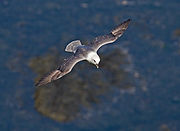
Family Diomedeidae
- Shy AlbatrossShy AlbatrossThe Shy Albatross or Shy Mollymawk, Thalassarche cauta, is a medium sized albatross that breeds off Australia and New Zealand's sub-Antarctic islands and ranges extensively across the Southern Ocean...
Thalassarche cauta - Laysan AlbatrossLaysan AlbatrossThe Laysan Albatross, Phoebastria immutabilis, is a large seabird that ranges across the North Pacific. This small two-tone gull-like albatross is the second most common seabird in the Hawaiian Islands, with an estimated population of 2.5 million birds, and is currently expanding its range to new...
Phoebastria immutabilis - Black-footed AlbatrossBlack-footed AlbatrossThe Black-footed Albatross, Phoebastria nigripes, is a large seabird from the North Pacific of the albatross family Diomedeidae. It is one of three species of albatross that range in the northern hemisphere, nesting on isolated tropical islands...
Phoebastria nigripes - Short-tailed AlbatrossShort-tailed AlbatrossThe Short-tailed Albatross or Steller's Albatross, Phoebastria albatrus, is a large rare seabird from the North Pacific. Although related to the other North Pacific albatrosses, it also exhibits behavioural and morphological links to the albatrosses of the Southern Ocean...
Phoebastria albatrus
Family ProcellariidaeProcellariidaeThe family Procellariidae is a group of seabirds that comprises the fulmarine petrels, the gadfly petrels, the prions, and the shearwaters. This family is part of the bird order Procellariiformes , which also includes the albatrosses, the storm-petrels, and the diving petrels.The procellariids are...
- Northern FulmarNorthern FulmarThe Northern Fulmar, Fulmarus glacialis, Fulmar, or Arctic Fulmar is a highly abundant sea bird found primarily in subarctic regions of the north Atlantic and north Pacific oceans. Fulmars come in one of two color morphs: a light one which is almost entirely white, and a dark one which is...
Fulmarus glacialis - Murphy's PetrelMurphy's PetrelMurphy's Petrel is a species of seabird and a member of the gadfly petrels. The bird is 38-41 cm in size, with a 97 cm wingspan....
Pterodroma ultima - Mottled PetrelMottled PetrelThe Mottled Petrel is a species of seabird and a member of the gadfly petrels. The bird is 33-35 cm in size, with a 74-82 cm wingspan....
Pterodroma inexpectata - Juan Fernandez PetrelJuan Fernández PetrelThe Juan Fernández Petrel, Pétrel De Juan Fernandez, or Peterel De Las Juan Fernádez is a species of seabird in the Procellariidae family....
Pterodroma externa - Cook's PetrelCook's PetrelCook's Petrel , one of the smallest petrels, is a species of seabird and a member of the gadfly petrels. The bird is 25-30 cm in size, with a 65-66 cm wingspan...
Pterodroma cookii - Streaked ShearwaterStreaked ShearwaterThe Streaked Shearwater, Calonectris leucomelas is a species of seabird. The bird is 48 cm in size, with a 122 cm wingspan. This species is pelagic, but also occurs in inshore waters. It occurs in the Pacific Ocean, nesting in Japan and many of its offshore islands. After breeding, the Streaked...
Calonectris leucomelas - Pink-footed ShearwaterPink-footed ShearwaterThe Pink-footed Shearwater is a species of seabird. The bird is 48 cm in size, with a 109 cm wingspan. It is polymorphic, having both darker and lighter phase populations...
Puffinus creatopus - Flesh-footed ShearwaterFlesh-footed ShearwaterThe Flesh-footed Shearwater, Puffinus carneipes, is a small shearwater. Its plumage is black. It has pale pinkish feet, and a pale bill with a black tip. Together with the equally light-billed Pink-footed Shearwater, it forms the Hemipuffinus group, a superspecies which may or may not have an...
Puffinus carneipes - Wedge-tailed ShearwaterWedge-tailed ShearwaterThe Wedge-tailed Shearwater, Puffinus pacificus is a medium-large shearwater in the seabird family Procellariidae. It is one of the shearwater species that is sometimes referred to as a Muttonbird, like the Sooty Shearwater of New Zealand and the Short-tailed Shearwater of Australia...
Puffinus pacificus - Buller's ShearwaterBuller's ShearwaterBuller's Shearwater is a Pacific species of seabird in the family Procellariidae; it is also known as the Grey-backed Shearwater or New Zealand Shearwater...
Puffinus bulleri - Sooty ShearwaterSooty ShearwaterThe Sooty Shearwater is a medium-large shearwater in the seabird family Procellariidae. In New Zealand it is also known by its Māori name tītī and as "muttonbird", like its relatives the Wedge-tailed Shearwater and the Australian Short-tailed Shearwater The Sooty Shearwater (Puffinus griseus) is...
Puffinus griseus - Short-tailed ShearwaterShort-tailed ShearwaterThe Short-tailed Shearwater or Slender-billed Shearwater , also called Yolla or Moonbird, and commonly known as the muttonbird in Australia, is the most abundant seabird species in Australian waters, and is one of the few Australian native birds in which the chicks are commercially harvested...
Puffinus tenuirostris - Manx ShearwaterManx ShearwaterThe Manx Shearwater is a medium-sized shearwater in the seabird family Procellariidae. The scientific name of this species records a name shift: Manx Shearwaters were called Manks Puffins in the 17th century. Puffin is an Anglo-Norman word for the cured carcasses of nestling shearwaters...
Puffinus puffinus - Black-vented ShearwaterBlack-vented ShearwaterThe Black-vented Shearwater is a species of seabird. The bird is 30–38 cm in size, with a 76–89 cm wingspan. Formerly considered a subspecies of the Manx Shearwater, its actual relationships are unresolved....
Puffinus opisthomelas
Family Hydrobatidae
- Wilson's Storm-PetrelWilson's Storm-petrelWilson's Storm Petrel , also known as Wilson's Petrel, is a small seabird of the storm-petrel family. It is one of the most abundant bird species in the world and has a circumpolar distribution mainly in the seas of the southern hemisphere but extending northwards during the summer of the northern...
Oceanites oceanicus - Fork-tailed Storm-PetrelFork-tailed Storm-petrelThe Fork-tailed Storm Petrel is a small seabird of the storm-petrel family Hydrobatidae. It is 20–23 cm in length, with a wingspan of 46 cm...
Oceanodroma furcata - Leach's Storm-PetrelLeach's Storm-petrelThe Leach's Storm Petrel or Leach's Petrel is a small seabird of the tubenose family. It is named after the British zoologist William Elford Leach....
Oceanodroma leucorhoa - Black Storm-PetrelBlack Storm-petrelThe Black Storm Petrel is a small seabird of the storm-petrel family Hydrobatidae. It is 23 cm in length, with a wingspan of 46–51 cm....
Oceanodroma melania
Order PelecaniformesPelecaniformesThe Pelecaniformes is a order of medium-sized and large waterbirds found worldwide. As traditionally—but erroneously—defined, they encompass all birds that have feet with all four toes webbed. Hence, they were formerly also known by such names as totipalmates or steganopodes...
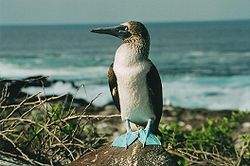
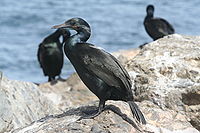
Family Sulidae
- Masked BoobyMasked BoobyThe Masked Booby, Sula dactylatra, is a large seabird of the booby family, Sulidae. This species breeds on islands in tropical oceans, except in the eastern Atlantic; in the eastern Pacific it is replaced by the Nazca Booby, Sula granti, which was formerly regarded as a subspecies of Masked Booby...
Sula dactylatra - Blue-footed BoobyBlue-footed BoobyThe Blue-footed Booby is a bird in the Sulidae family which comprises ten species of long-winged seabirds. The natural breeding habitat of the Blue-footed Booby is tropical and subtropical islands off the Pacific Ocean, most famously, the Galápagos Islands, Ecuador.- Etymology :The name booby...
Sula nebouxii - Brown BoobyBrown BoobyThe Brown Booby is a large seabird of the booby family, Sulidae. The adult brown booby reaches about in length. Its head and upper body are covered in dark brown, with the remainder being a contrasting white. The juvenile form is gray-brown with darkening on the head, wings and tail...
Sula leucogaster
Family Pelecanidae
- American White PelicanAmerican White PelicanThe American White Pelican is a large aquatic bird from the order Pelecaniformes. It breeds in interior North America, moving south and to the coasts, as far as Central America, in winter....
Pelecanus erythrorhynchos - Brown PelicanBrown PelicanThe Brown Pelican is the smallest of the eight species of pelican, although it is a large bird in nearly every other regard. It is in length, weighs from and has a wingspan from .-Range and habits:...
Pelecanus occidentalis
Family Phalacrocoracidae
- Brandt's CormorantBrandt's CormorantThe Brandt's Cormorant is a strictly marine bird of the cormorant family of seabirds that inhabits the Pacific coast of North America. It ranges, in the summer, from Alaska to the Gulf of California, but the population north of Vancouver Island migrates south during the winter...
Phalacrocorax penicillatus - Double-crested CormorantDouble-crested CormorantThe Double-crested Cormorant is a member of the cormorant family of seabirds. It occurs along inland waterways as well as in coastal areas, and is widely distributed across North America, from the Aleutian Islands in Alaska down to Florida and Mexico...
Phalacrocorax auritus - Pelagic CormorantPelagic CormorantThe Pelagic Cormorant , also known as Baird's Cormorant, is a small member of the cormorant family Phalacrocoracidae. Analogous to other smallish cormorants, it is also called Pelagic Shag occasionally...
Phalacrocorax pelagicus
Order CiconiiformesCiconiiformesTraditionally, the order Ciconiiformes has included a variety of large, long-legged wading birds with large bills: storks, herons, egrets, ibises, spoonbills, and several others. Ciconiiformes are known from the Late Eocene...

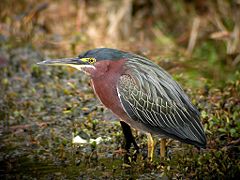
Family Ardeidae
- American BitternAmerican BitternThe American Bittern is a wading bird of the heron family Ardeidae. New evidence has led the American Ornithologists' Union to move the heron family into the order Pelecaniformes .-Description:...
Botaurus lentiginosus - Least BitternLeast BitternThe Least Bittern is a small wading bird, the smallest heron found in the Americas.This bird's underparts and throat are white with light brown streaks. Their face and the sides of the neck are light brown; they have yellow eyes and a yellow bill. The adult male is glossy greenish black on the...
Ixobrychus exilis - Great Blue HeronGreat Blue HeronThe Great Blue Heron is a large wading bird in the heron family Ardeidae, common near the shores of open water and in wetlands over most of North and Central America as well as the West Indies and the Galápagos Islands. It is a rare vagrant to Europe, with records from Spain, the Azores and England...
Ardea herodias - Great EgretGreat EgretThe Great Egret , also known as the Great White Egret or Common Egret, White Heron, or Great White Heron, is a large, widely-distributed egret. Distributed across most of the tropical and warmer temperate regions of the world, in southern Europe it is rather localized...
Ardea alba - Snowy EgretSnowy EgretThe Snowy Egret is a small white heron. It is the American counterpart to the very similar Old World Little Egret, which has established a foothold in the Bahamas....
Egretta thula - Little Blue HeronLittle Blue HeronThe Little Blue Heron, Egretta caerulea, is a small heron. It breeds from the Gulf states of the USA through Central America and the Caribbean south to Peru and Uruguay. It is a resident breeder in most of its range, but some northern breeders migrate to the southeastern USA or beyond in winter...
Egretta caerulea - Tricolored HeronTricolored HeronThe Tricolored Heron formerly known in North America as the Louisiana Heron, is a small heron. It is a resident breeder from the Gulf states of the USA and northern Mexico south through Central America and the Caribbean to central Brazil and Peru...
Egretta tricolor - Cattle EgretCattle EgretThe Cattle Egret is a cosmopolitan species of heron found in the tropics, subtropics and warm temperate zones. It is the only member of the monotypic genus Bubulcus, although some authorities regard its two subspecies as full species, the Western Cattle Egret and the Eastern Cattle Egret...
Bubulcus ibis - Green HeronGreen HeronThe Green Heron is a small heron of North and Central America. It was long considered conspecific with its sister species the Striated Heron , and together they were called "Green-backed Heron"...
Butorides virescens - Black-crowned Night-Heron Nycticorax nycticorax
Family ThreskiornithidaeThreskiornithidaeThe family Threskiornithidae includes 34 species of large terrestrial and wading birds, falling into two subfamilies, the ibises and the spoonbills. It was formerly known as Plataleidae. The spoonbills and ibises were once thought to be related to other groups of long-legged wading birds in the...
Subfamily Threskiornithinae
- American White IbisAmerican White IbisThe American White Ibis is a species of wading bird in the ibis family Threskiornithidae. It occurs from the mid-Atlantic and Gulf coast of the United States south through most of the New World tropics...
Eudocimus albus - Glossy IbisGlossy IbisThe Glossy Ibis is a wading bird in the ibis family Threskiornithidae.This is the most widespread ibis species, breeding in scattered sites in warm regions of Europe, Asia, Africa, Australia, and the Atlantic and Caribbean region of the Americas...
Plegadis falcinellus - White-faced IbisWhite-faced IbisThe White-faced Ibis is a wading bird in the ibis family Threskiornithidae.This species breeds colonially in marshes, usually nesting in bushes or low trees. Its breeding range extends from the western USA south through Mexico, as well as from southeastern Brazil and southeastern Bolivia south to...
Plegadis chihi
Order FalconiformesFalconiformesThe order Falconiformes is a group of about 290 species of birds that comprises the diurnal birds of prey. Raptor classification is difficult and the order is treated in several ways.- Classification problems :...
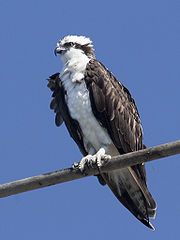

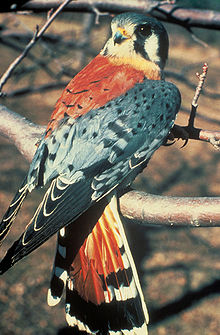
Family Cathartidae
- Turkey VultureTurkey VultureThe Turkey Vulture is a bird found throughout most of the Americas. It is also known in some North American regions as the Turkey Buzzard , and in some areas of the Caribbean as the John Crow or Carrion Crow...
Cathartes aura - California CondorCalifornia CondorThe California Condor is a New World vulture, the largest North American land bird. Currently, this condor inhabits only the Grand Canyon area, Zion National Park, and coastal mountains of central and southern California and northern Baja California...
Gymnogyps californianus
Family AccipitridaeAccipitridaeThe Accipitridae, one of the two major families within the order Accipitriformes , are a family of small to large birds with strongly hooked bills and variable morphology based on diet. They feed on a range of prey items from insects to medium-sized mammals, with a number feeding on carrion and a...
Subfamily Pandioninae
- OspreyOspreyThe Osprey , sometimes known as the sea hawk or fish eagle, is a diurnal, fish-eating bird of prey. It is a large raptor, reaching more than in length and across the wings...
Pandion haliaetus
Subfamily Accepitrinae
- White-tailed KiteWhite-tailed KiteThe White-tailed Kite is an elanid kite of genus Elanus found in western North America and parts of South America.Their coloration is gull-like, but their shape and flight falcon-like, with a rounded tail...
Elanus leucurus - Bald EagleBald EagleThe Bald Eagle is a bird of prey found in North America. It is the national bird and symbol of the United States of America. This sea eagle has two known sub-species and forms a species pair with the White-tailed Eagle...
Haliaeetus leucocephalus - Northern Harrier Circus cyaneus
- Sharp-shinned HawkSharp-shinned HawkThe Sharp-shinned Hawk is a small hawk. In fact, "sharp-shins" or "sharpies" are the smallest to reside in USA and Canada, though some Neotropical species are smaller...
Accipiter striatus - Cooper's HawkCooper's HawkCooper's Hawk is a medium-sized hawk native to the North American continent and found from Canada to Mexico. As in many birds of prey, the male is smaller than the female...
Accipiter cooperii - Northern Goshawk Accipiter gentilis
- Red-shouldered HawkRed-shouldered HawkThe Red-shouldered Hawk is a medium-sized hawk. Its breeding range spans eastern North America and along the coast of California and northern to northeastern-central Mexico.-Description:...
Buteo lineatus - Broad-winged HawkBroad-winged HawkThe Broad-winged Hawk is a small hawk of the genus Buteo. During the summer some subspecies are distributed over eastern North America, as far west as British Columbia and Texas; they then migrate south to winter in the neotropics from Mexico down to southern Brazil. Other subspecies are all-year...
Buteo platypterus - Swainson's HawkSwainson's HawkThe Swainson's Hawk , is a large buteo hawk of the Falconiformes, sometimes separated in the Accipitriformes like its relatives. This species was named after William Swainson, a British naturalist...
Buteo swainsoni - Red-tailed HawkRed-tailed HawkThe Red-tailed Hawk is a bird of prey, one of three species colloquially known in the United States as the "chickenhawk," though it rarely preys on standard sized chickens. It breeds throughout most of North America, from western Alaska and northern Canada to as far south as Panama and the West...
Buteo jamaicensis - Ferruginous HawkFerruginous HawkThe Ferruginous Hawk , Buteo regalis , is a large bird of prey. It is not a true hawk like sparrowhawks or goshawks, but rather belongs to the broad-winged buteo hawks, known as "buzzards" in Europe...
Buteo regalis - Rough-legged Hawk Buteo lagopus
- Golden EagleGolden EagleThe Golden Eagle is one of the best known birds of prey in the Northern Hemisphere. Like all eagles, it belongs to the family Accipitridae. Once widespread across the Holarctic, it has disappeared from many of the more heavily populated areas...
Aquila chrysaetos
Family FalconidaeFalconidaeThe falcons and caracaras are around 60 species of diurnal birds of prey that make up the family Falconidae. The family is divided into two subfamiles, Polyborinae, which includes the caracaras and forest falcons, and Falconinae, the falcons, kestrels and falconets.-Description:Falcons and...
Subfamily Caracarinae
- Crested CaracaraCrested CaracaraThe Northern Caracara, or Crested Caracara as it is properly known where it lives in the Americas, is a bird of prey in the family Falconidae. It was formerly considered conspecific with the Southern Caracara and the extinct Guadalupe Caracara as the "Crested Caracara"...
Caracara cheriway
Subfamily Falconinae
- American KestrelAmerican KestrelThe American Kestrel , sometimes colloquially known as the Sparrow Hawk, is a small falcon, and the only kestrel found in the Americas. It is the most common falcon in North America, and is found in a wide variety of habitats. At long, it is also the smallest falcon in North America...
Falco sparverius - MerlinMerlin (bird)The Merlin is a small species of falcon from the Northern Hemisphere. A bird of prey once known colloquially as a pigeon hawk in North America, the Merlin breeds in the northern Holarctic; some migrate to subtropical and northern tropical regions in winter.-European and North American...
Falco columbarius - GyrfalconGyrfalconThe Gyrfalcon — Falco rusticolus — is the largest of the falcon species. The Gyrfalcon breeds on Arctic coasts and the islands of North America, Europe, and Asia. It is mainly resident there also, but some Gyrfalcons disperse more widely after the breeding season, or in winter.Individual vagrancy...
Falco rusticolus - Peregrine FalconPeregrine FalconThe Peregrine Falcon , also known as the Peregrine, and historically as the Duck Hawk in North America, is a widespread bird of prey in the family Falconidae. A large, crow-sized falcon, it has a blue-gray back, barred white underparts, and a black head and "moustache"...
Falco peregrinus - Prairie FalconPrairie FalconThe Prairie Falcon is a medium-sized falcon of western North America.It is about the size of a Peregrine Falcon or a crow, with an average length of 40 cm , wingspan of 1 metre , and weight of 720 g...
Falco mexicanus
Family RallidaeRallidaeThe rails, or Rallidae, are a large cosmopolitan family of small to medium-sized birds. The family exhibits considerable diversity and the family also includes the crakes, coots, and gallinules...
- Yellow RailYellow RailThe Yellow Rail, Coturnicops noveboracensis, is a small waterbird, of the family Rallidae.Adults have brown upperparts streaked with black, a yellowish-brown breast, a light belly and barred flanks. The short thick dark bill turns yellow in males during the breeding season. The feathers on the back...
Coturnicops noveboracensis - Virginia RailVirginia RailThe Virginia Rail, Rallus limicola, is a small waterbird, of the family Rallidae.Adults are mainly brown, darker on the back and crown, with orange-brown legs. They have long toes, a short tail and a long slim reddish bill...
Rallus limicola - SoraSora (crake)The Sora is a small waterbird of the family Rallidae, sometimes also referred to as the Sora Rail or Sora Crake.Adults Soras are long, with dark-marked brown upperparts, a blue-grey face and underparts, and black and white barring on the flanks. They have a short thick yellow bill, with black...
Porzana carolina - Common MoorhenCommon MoorhenThe Common Moorhen is a bird in the Rallidae family with an almost worldwide distribution. The North and South American Committees of the AOU and the IOC have voted on or before July 2011 to split the American forms into a new species Common Gallinule, however, no other committee has voted to...
Gallinula chloropus - American CootAmerican CootThe American Coot is a bird of the family Rallidae, inhabiting wetlands and open water bodies. Measuring in length and across the wings, adults have a short thick white bill and white frontal shield, which usually has a reddish-brown spot near the top of the bill between the eyes...
Fulica americana
Order CharadriiformesCharadriiformesCharadriiformes is a diverse order of small to medium-large birds. It includes about 350 species and has members in all parts of the world. Most Charadriiformes live near water and eat invertebrates or other small animals; however, some are pelagic , some occupy deserts and a few are found in thick...

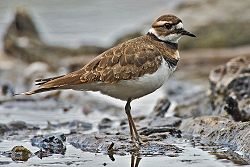
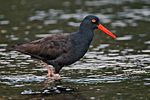
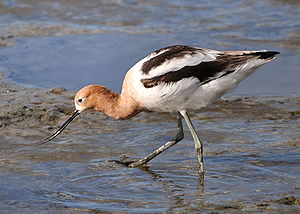
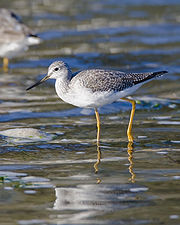
.jpg)
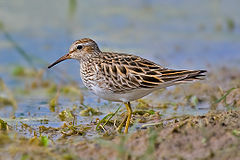
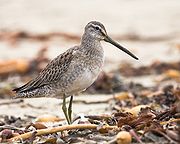

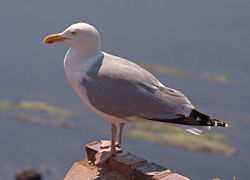
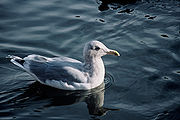


Family CharadriidaeCharadriidaeThe bird family Charadriidae includes the plovers, dotterels, and lapwings, about 64 to 66 species in all.- Morphology :They are small to medium-sized birds with compact bodies, short, thick necks and long, usually pointed, wings, but most species of lapwing may have more rounded wings...
Subfamily Charadriinae
- Black-bellied Plover Pluvialis squatarola
- American Golden-Plover Pluvialis dominica
- Pacific Golden-Plover Pluvialis fulva
- Lesser Sand-Plover Charadrius mongolus
- Snowy PloverSnowy PloverThe Snowy Plover is a small wader in the plover bird family. It breeds in Ecuador, Peru, Chile, the southern and western USA and the Caribbean...
Charadrius alexandrinus - Wilson's PloverWilson's PloverThe Wilson's Plover is a small plover.Wilson's Plover is a coastal wader which breeds on both coasts of the Americas from the equator northwards. Its range extends north to include much of the U.S. eastern seaboard, and the Pacific coast of Mexico on the west.It is a partial migrant. Birds leave...
Charadrius wilsonia - Semipalmated PloverSemipalmated PloverThe Semipalmated Plover is a small plover.This species weighs and measures in length and across the wings. Adults have a grey-brown back and wings, a white belly, and a white breast with one black neckband...
Charadrius semipalmatus- Piping PloverPiping PloverThe Piping Plover is a small sand-colored, sparrow-sized shorebird that nests and feeds along coastal sand and gravel beaches in North America. The adult has yellow-orange legs, a black band across the forehead from eye to eye, and a black ring around the neck...
Charadrius melodus
- Piping Plover
- KilldeerKilldeerThe Killdeer is a medium-sized plover.Adults have a brown back and wings, a white belly, and a white breast with two black bands. The rump is tawny orange. The face and cap are brown with a white forehead. They have an orange-red eyering...
Charadrius vociferus - Mountain PloverMountain PloverThe Mountain Plover is a medium-sized ground bird in the plover family . It is misnamed, as it lives on level land...
Charadrius montanus - Eurasian DotterelEurasian DotterelThe Eurasian Dotterel , or in Europe just Dotterel, is a small wader in the plover family of birds.It breeds in the Arctic tundra of northern Eurasia, from Norway to eastern Siberia, and on suitable mountain plateaus such as the Scottish highlands and the Alps...
Charadrius morinellus
Family RecurvirostridaeRecurvirostridaeRecurvirostridae is a family of birds in the wader suborder Charadrii. It contains two distinct groups of birds, the avocets and the stilts .-Description and diet:...
- Black-necked StiltBlack-necked StiltThe Black-necked Stilt is a locally abundant shorebird of American wetlands and coastlines. It is found from the coastal areas of California through much of the interior western United States and along the Gulf of Mexico as far east as Florida, then south through Central America and the Caribbean...
Himantopus mexicanus - American AvocetAmerican AvocetThe American Avocet is a large wader in the avocet and stilt family, Recurvirostridae.This avocet has long, thin, gray legs, giving it its colloquial name, "blue shanks". The plumage is black and white on the back with white on the underbelly. The neck and head are cinnamon colored in the summer...
Recurvirostra americana
Family ScolopacidaeScolopacidaeThe sandpipers are a large family, Scolopacidae, of waders or shorebirds. They include many species called sandpipers, as well as those called by names such as curlew and snipe. The majority of these species eat small invertebrates picked out of the mud or soil...
Subfamily Scolopacinae
- Spotted SandpiperSpotted SandpiperThe Spotted Sandpiper is a small shorebird, 18–20 cm long. Together with its sister species, the Common Sandpiper they make up the genus Actitis...
Actitis macularius - Solitary SandpiperSolitary SandpiperThe Solitary Sandpiper is a small wader .-Description:This species measures long, with a wingspan up to and a body mass of . It is a dumpy wader with a dark green back, greyish head and breast and otherwise white underparts. It is obvious in flight, with wings dark above and below, and a dark...
Tringa solitaria - Wandering TattlerWandering TattlerThe Wandering Tattler, Tringa incana , is a medium-sized wading bird. It is similar in appearance to the closely related Gray-tailed Tattler, T. brevipes...
Tringa incanus - Spotted RedshankSpotted RedshankThe Spotted Redshank, Tringa erythropus, is a wader in the large bird family Scolopacidae. It breeds across northern Scandinavia and northern Asia and migrates south to the Mediterranean, the southern British Isles, France, tropical Africa, and tropical Asia for the winter...
Tringa erythropus - Greater YellowlegsGreater YellowlegsThe Greater Yellowlegs, Tringa melanoleuca, is a large North American shorebird, similar in appearance to the smaller Lesser Yellowlegs. Its closest relative, however, is the Greenshank, which together with the Spotted Redshank form a close-knit group...
Tringa melanoleuca - WilletWilletThe Willet, Tringa semipalmata , is a large shorebird in the sandpiper family. It is a good-sized and stout scolopacid, the largest of the shanks...
Tringa semipalmata - Lesser YellowlegsLesser YellowlegsThe Lesser Yellowlegs is a medium-sized shorebird similar in appearance to the larger Greater Yellowlegs. It is not closely related to this bird, however, but instead to the much larger and quite dissimilar Willet; merely the fine, clear and dense pattern of the neck shown in breeding plumage...
Tringa flavipes - Upland SandpiperUpland SandpiperThe Upland Sandpiper is a large shorebird, closely related to the curlews . Older names are the Upland Plover and Bartram's Sandpiper. It is the only member of the genus Bartramia. The genus name and the old common name Bartram's Sandpiper commemorate the American naturalist William Bartram...
Bartramia longicauda - WhimbrelWhimbrelThe Whimbrel Numenius phaeopus, is a wader in the large family Scolopacidae. It is one of the mostwidespread of the curlews, breeding across much of subarctic North America, Europe and Asia as far south as Scotland....
Numenius phaeopus - Bristle-thighed CurlewBristle-thighed CurlewThe Bristle-thighed Curlew, Numenius tahitiensis, is a large shorebird that breeds in Alaska and winters on tropical Pacific islands. It has a long, decurved bill and bristled feathers at the base of the legs. Its length is about 43 cm and wingspan about 84 cm...
Numenius tahitiensis - Long-billed CurlewLong-billed CurlewThe Long-billed Curlew, Numenius americanus, is a large North American shorebird of the family Scolopacidae. This species was also called "sicklebird" and the "candlestick bird". The species is native to central and western North America...
Numenius americanus - Hudsonian GodwitHudsonian GodwitThe Hudsonian Godwit, Limosa haemastica, is a large shorebird.-Identification:Adults have long dark legs and a long pink bill with a slight upward curve and dark at the tip. The upper parts are mottled brown and the underparts are chestnut. The tail is black and the rump is white...
Limosa haemastica - Bar-tailed GodwitBar-tailed GodwitThe Bar-tailed Godwit is a large wader in the family Scolopacidae, which breeds on Arctic coasts and tundra mainly in the Old World, and winters on coasts in temperate and tropical regions of the Old World...
Limosa lapponica - Marbled GodwitMarbled GodwitThe Marbled Godwit, Limosa fedoa, is a large shorebird. On average, it is the largest of the 4 species of godwit. The total length is , including a large bill of , and wingspan is . Body mass can vary from ....
Limosa fedoa - Ruddy TurnstoneRuddy TurnstoneThe Ruddy Turnstone is a small wading bird, one of two species of turnstone in the genus Arenaria. It is now classified in the sandpiper family Scolopacidae but was formerly sometimes placed in the plover family Charadriidae...
Arenaria interpres - Black TurnstoneBlack TurnstoneThe Black Turnstone is a species of small wading bird. It is one of two species of turnstone in the genus Arenaria, the Ruddy Turnstone being the other. It is now classified in the sandpiper family Scolopacidae but was formerly sometimes placed in the plover family Charadriidae...
Arenaria melanocephala - SurfbirdSurfbirdThe Surfbird is a small stocky wader in the family Scolopacidae. It is usually classified in a genus of its own, as Aphriza virgata, and was once considered to be allied to the turnstones, but more recent data suggests it is very close genetically to the Red and Great Knots and should be included...
Aphriza virgata - Great KnotGreat KnotThe Great Knot, Calidris tenuirostris, is a small wader. It is the largest of the calidrid species.Their breeding habitat is tundra in northeast Siberia. They nest on the ground laying about four eggs in a ground scrape. They are strongly migratory wintering on coasts in southern Asia through to...
Calidris tenuirostris - Red KnotRed KnotThe Red Knot, Calidris canutus , is a medium sized shorebird which breeds in tundra and the Arctic Cordillera in the far north of Canada, Europe, and Russia. It is a large member of the Calidris sandpipers, second only to the Great Knot...
Calidris canutus - SanderlingSanderlingThe Sanderling is a small wader. It is a circumpolar Arctic breeder, and is a long-distance migrant, wintering south to South America, South Europe, Africa, and Australia...
Calidris alba - Semipalmated SandpiperSemipalmated SandpiperThe Semipalmated Sandpiper, Calidris pusilla, is a very small shorebird. It is sometimes separated with other "stints" in Erolia but although these apparently form a monophyletic group, the present species' old genus Ereunetes had been proposed before Erolia.Adults have black legs and a short stout...
Calidris pusilla - Western SandpiperWestern SandpiperThe Western Sandpiper, Calidris or Erolia mauri, is a small shorebird.Adults have dark legs and a short thin dark bill, thinner at the tip. The body is brown on top and white underneath. They are reddish-brown on the crown. This bird can be difficult to distinguish from other similar tiny...
Calidris mauri - Red-necked StintRed-necked StintThe Red-necked Stint is a small migratory wader.- Description :These birds are among the smallest of waders, very similar to the Little Stint, Calidris minuta, with which they were once considered conspecific...
Calidris ruficollis - Little StintLittle StintThe Little Stint, Calidris minuta , is a very small wader. It breeds in arctic Europe and Asia, and is a long-distance migrant, wintering south to Africa and south Asia...
Calidris minuta - Long-toed StintLong-toed StintThe Long-toed Stint, Calidris or Erolia subminuta, is a small wader bird. It breeds across northern Asia and is strongly migratory, wintering in south and south east Asia and Australasia...
Calidris subminuta - Least SandpiperLeast SandpiperThe Least Sandpiper is the smallest shorebird.This species has greenish legs and a short thin dark bill. Breeding adults are brown with dark brown streaks on top and white underneath. They have a light line above the eye and a dark crown. In winter, Least Sandpipers are grey above...
Calidris minutilla - White-rumped SandpiperWhite-rumped SandpiperThe White-rumped Sandpiper is a small shorebird.Adults have black legs and a small thin dark bill. The body is dark brown on top and mainly white underneath, with brown streaks on the breast and a white rump. They have a white stripe over their eyes. This bird shows long wings in flight. In winter...
Calidris fuscicollis - Baird's SandpiperBaird's SandpiperThe Baird's Sandpiper is a small shorebird. It is among those calidrids sometimes separated in Erolia.Adults have black legs and a short thin dark bill. They are dark brown on top and mainly white underneath with a black patch on the rump. The head and breast are light brown with dark streaks. In...
Calidris bairdii - Pectoral SandpiperPectoral SandpiperThe Pectoral Sandpiper, Calidris melanotos, is a small wader. It is sometimes separated with the "stint" sandpipers in Erolia. This may or may not represent a good monophyletic group, depending on the placement of the phylogenetically enigmatic Curlew Sandpiper , the type species of Erolia...
Calidris melanotos - Sharp-tailed SandpiperSharp-tailed SandpiperThe Sharp-tailed Sandpiper, Calidris acuminata is a small wader.- Taxonomy :More recently, a review of new data has indicated that this bird should perhaps better be placed into the genus Philomachus- as P...
Calidris acuminata - Rock SandpiperRock SandpiperThe Rock Sandpiper is a small shorebird.Adults have short yellow legs and a medium thin dark bill. The body is dark on top with a slight purplish gloss and mainly white underneath. The breast is smeared with grey and the rump is black...
Calidris ptilocnemis - DunlinDunlinThe Dunlin, Calidris alpina, is a small wader, sometimes separated with the other "stints" in Erolia. It is a circumpolar breeder in Arctic or subarctic regions. Birds that breed in northern Europe and Asia are long-distance migrants, wintering south to Africa, southeast Asia and the Middle East...
Calidris alpina - Curlew SandpiperCurlew SandpiperThe Curlew Sandpiper is a small wader that breeds on the tundra of Arctic Siberia. It is strongly migratory, wintering mainly in Africa, but also in south and southeast Asia and in Australasia...
Calidris ferruginea - Stilt SandpiperStilt SandpiperThe Stilt Sandpiper, Calidris himantopus or Micropalama himantopus, is a small shorebird; it bears some resemblance to the smaller calidrid sandpipers or "stints". DNA sequence information is incapable of determining whether it should be placed in Calidris or in the monotypic genus Micropalama...
Calidris himantopus - Buff-breasted SandpiperBuff-breasted SandpiperThe Buff-breasted Sandpiper, Tryngites subruficollis, is a small shorebird. It is a calidrid sandpipers and currently considered to be the only member of the genus Tryngites. Indeed, it probably belongs in the genus Calidris itself, or more precisely with the small species thereof which should be...
Tryngites subruficollis - RuffRuffThe Ruff is a medium-sized wading bird that breeds in marshes and wet meadows across northern Eurasia. This highly gregarious sandpiper is migratory and sometimes forms huge flocks in its winter grounds, which include southern and western Europe, Africa, southern Asia and Australia...
Philomachus pugnax - Short-billed DowitcherShort-billed DowitcherThe Short-billed Dowitcher like its congener the Long-billed Dowitcher, is a medium-sized, stocky, long-billed shorebird in the family Scolopacidae. It is an inhabitant of North America, Middle America, and northern South America. It is strongly migratory; it completely vacates in breeding areas...
Limnodromus griseus - Long-billed DowitcherLong-billed DowitcherThe Long-billed Dowitcher, Limnodromus scolopaceus, is a medium-sized shorebird.Adults have yellowish legs and a long straight dark bill. The body is dark brown on top and reddish underneath with spotted throat and breast, bars on flanks. The tail has a black and white barred pattern...
Limnodromus scolopaceus - Jack SnipeJack SnipeThe Jack Snipe, Lymnocryptes minimus is a small stocky wader. It is the smallest snipe, and the only member of the genus Lymnocryptes...
Lymnocryptes minimus - Wilson's SnipeWilson's SnipeWilson's Snipe is a small, stocky shorebird. This species was formerly considered to be a subspecies of the Common Snipe, G. gallinago. Wilson's Snipe differs from the latter species in having a narrower white edge to the wings, and eight pairs of tail feathers instead of seven.Adults are...
Gallinago delicata
Subfamily Phalaropodinae
- Wilson's PhalaropeWilson's PhalaropeThe Wilson's Phalarope, Phalaropus tricolor, is a small wader. This bird, the largest of the phalaropes, breeds in the prairies of North America in western Canada and the western United States. It is migratory, wintering around the central Andes in South America. They are passage migrants through...
Phalaropus tricolor - Red-necked PhalaropeRed-necked PhalaropeThe Red-necked Phalarope, Phalaropus lobatus, is a small wader. This phalarope breeds in the Arctic regions of North America and Eurasia. It is migratory, and, unusually for a wader, winters at sea on tropical oceans....
Phalaropus lobatus - Red PhalaropeRed PhalaropeThe Red Phalarope , Phalaropus fulicarius, is a small wader. This phalarope breeds in the Arctic regions of North America and Eurasia...
Phalaropus fulicarius
Family Laridae
Subfamily Larinae- Laughing GullLaughing GullThe Laughing Gull, Leucophaeus atricilla, is a medium-sized gull of North and South America. It breeds on the Atlantic coast of North America, the Caribbean, and northern South America. Northernmost populations migrate further south in winter, and this species occurs as a rare vagrant to western...
Larus atricilla - Franklin's GullFranklin's GullThe Franklin's Gull is a small gull.-Description:It breeds in central provinces of Canada and adjacent states of the northern United States...
Larus pipixcan - Little GullLittle GullThe Little Gull, Hydrocoloeus minutus or Larus minutus, is a small gull which breeds in northern Europe and Asia. It also has small colonies in parts of southern Canada. It is migratory, wintering on coasts in western Europe, the Mediterranean and the northeast USA. As is the case with many gulls,...
Larus minutus - Black-headed GullBlack-headed GullThe Black-headed Gull is a small gull which breeds in much of Europe and Asia, and also in coastal eastern Canada. Most of the population is migratory, wintering further south, but some birds in the milder westernmost areas of Europe are resident...
Larus ridibundus - Bonaparte's GullBonaparte's GullThe Bonaparte's Gull is a small gull.The Bonaparte's Gull is a small species, larger only than the Little Gull and the Saunders's Gull among all gull species. Adults are long with a wingspan and a body mass of . They have a black hood and a short thin dark bill. The body is mainly white with...
Larus philadelphia - Heermann's GullHeermann's GullThe Heermann's Gull is a gull resident in the United States, Mexico and extreme southwestern British Columbia. Of the current population of about 150,000 pairs, 90% nest on the island of Isla Rasa off Baja California in the Gulf of California, with smaller colonies as far north as California and...
Larus heermanni - Mew GullCommon GullThe Common Gull or Mew Gull Larus canus is a medium-sized gull which breeds in northern Asia, northern Europe and northwestern North America. It migrates further south in winter...
Larus canus - Ring-billed GullRing-billed GullThe Ring-billed Gull is a medium-sized gull.Adults are length and with a wingspan. The head, neck and underparts are white; the relatively short bill is yellow with a dark ring; the back and wings are silver gray; and the legs are yellow. The eyes are yellow with red rims...
Larus delawarensis - California GullCalifornia GullThe California Gull Larus californicus is a medium-sized gull, smaller on average than the Herring Gull but larger on average than the Ring-billed Gull, though may overlap in size greatly with both....
Larus californicus - Herring Gull Larus argentatus
- Thayer's GullThayer's GullThe Thayer's Gull is a large gull native to North America that breeds in the Arctic islands of Canada and primarily winters on the Pacific coast, from southern Alaska to the Gulf of California, though there are also wintering populations on the Great Lakes and the upper Mississippi River...
Larus thayeri - Iceland GullIceland GullThe Iceland Gull, Larus glaucoides, is a large gull which breeds in the Arctic regions of Canada and Greenland, but not Iceland, where it is only seen in the winter. It is migratory, wintering from in the North Atlantic as far south as the British Isles and northernmost states of the eastern USA,...
Larus glaucoides - Lesser Black-backed GullLesser Black-backed GullThe Lesser Black-backed Gull is a large gull that breeds on the Atlantic coasts of Europe. It is migratory, wintering from the British Isles south to West Africa...
Larus fuscus - Slaty-backed GullSlaty-backed GullThe Slaty-backed Gull , is a large white-headed gull that breeds on the western coast of Alaska but travels widely during nonbreeding seasons. Claims have been made as to its presence throughout North America as well as the eastern coast of Asia. It is similar in appearance to the Western Gull...
Larus schistisagus - Western GullWestern GullThe Western Gull, Larus occidentalis, is a large white-headed gull that lives on the western coast of North America. It was previously considered conspecific, the same species, with the Yellow-footed Gull of the Gulf of California...
Larus occidentalis - Glaucous-winged GullGlaucous-winged GullThe Glaucous-winged Gull, Larus glaucescens, is a large, white-headed gull residing from the western coast of Alaska to the coast of Washington. It also breeds on the northwest coast of Alaska. During non-breeding seasons they can be found along the coast of California...
Larus glaucescens - Glaucous GullGlaucous GullThe Glaucous Gull is a large gull which breeds in the Arctic regions of the northern hemisphere and the Atlantic coasts of Europe. It is migratory, wintering from in the North Atlantic and North Pacific oceans as far south as the British Isles and northernmost states of the USA, also on the Great...
Larus hyperboreus - Sabine's GullSabine's GullThe Sabine's Gull is a small gull. Its generic placement is disputed; some authors treat it as the sole species in the genus Xema as Xema sabini, while others retain it in the genus Larus as Larus sabini. It breeds in the arctic and has a circumpolar distribution through northernmost North America...
Xema sabini - Black-legged KittiwakeBlack-legged KittiwakeThe Black-legged Kittiwake is a seabird species in the gull family Laridae.This species was first described by Linnaeus in his Systema naturae in 1758 as Larus tridactylus....
Rissa tridactyla - Red-legged KittiwakeRed-legged KittiwakeThe Red-legged Kittiwake is a seabird species in the gull family Laridae. It breeds in the Pribilof, Bogoslof and Buldir islands of the USA, and the Commander Islands, Russia. Adults are long, with an wingspan and a body mass of ....
Rissa brevirostris - Ross's GullRoss's GullThe Ross's Gull is a small gull, the only species in its genus, although it has been suggested it should be moved to the genus Hydrocoloeus, which otherwise only includes the Little Gull....
Rhodostethia rosea
Subfamily Sterninae
- Least Tern Sternula antillarum
- Caspian TernCaspian TernThe Caspian Tern is a species of tern, with a subcosmopolitan but scattered distribution. Despite its extensive range, it is monotypic of its genus, and has no subspecies accepted either...
Hydroprogne caspia - Black TernBlack TernThe Black Tern, Chlidonias niger, is a small tern generally found in or near inland water in Europe and North America. As its name suggests, it has predominantly dark plumage.- Description :...
Chlidonias niger - Common TernCommon TernThe Common Tern is a seabird of the tern family Sternidae. This bird has a circumpolar distribution, breeding in temperate and sub-Arctic regions of Europe, Asia and east and central North America. It is strongly migratory, wintering in coastal tropical and subtropical regions. It is sometimes...
Sterna hirundo - Arctic TernArctic TernThe Arctic Tern is a seabird of the tern family Sternidae. This bird has a circumpolar breeding distribution covering the Arctic and sub-Arctic regions of Europe, Asia, and North America...
Sterna paradisaea - Forster's TernForster's TernThe Forster's Tern, Sterna forsteri, is a member of the tern family Sternidae. It breeds inland in North America and winters south to the Caribbean and northern South America....
Sterna forsteri - Elegant TernElegant TernThe Elegant Tern is a seabird of the tern family Sternidae. It breeds on the Pacific coasts of the southern USA and Mexico and winters south to Peru, Ecuador and Chile....
Thalasseus elegans
Family Stercorariidae
- South Polar SkuaSouth Polar SkuaThe South Polar Skua, Stercorarius maccormicki, is a large seabird in the skua family Stercorariidae. An older name for the bird is MacCormick’s Skua, after explorer and naval surgeon Robert McCormick, who first collected the type specimen...
Stercorarius maccormicki - Pomarine Jaeger Stercorarius pomarinus
- Parasitic Jaeger Stercorarius parasiticus
- Long-tailed Jaeger Stercorarius longicaudus
Family Alcidae
- Common Murre Uria aalge
- Thick-billed Murre Uria lomvia
- Pigeon GuillemotPigeon GuillemotThe Pigeon Guillemot is a medium-sized alcid endemic to the Pacific. They closely resemble the other members of the genus Cepphus, particularly the Black Guillemot, which is slightly smaller....
Cepphus columba - Long-billed MurreletLong-billed MurreletThe Long-billed Murrelet is a small seabird from the North Pacific. It is an unusual member of the auk family, often nesting far inland in old growth forests...
Brachyramphus perdix - Marbled MurreletMarbled MurreletThe Marbled Murrelet is a small seabird from the North Pacific. It is a member of the auk family. It nests in old-growth forests or on the ground at higher latitudes where trees cannot grow...
Brachyramphus marmoratus - Xantus's MurreletXantus's MurreletXantus's Murrelet is a small seabird found in the California Current system in the Pacific Ocean. This auk breeds on islands off California and Mexico...
Synthliboramphus hypoleucus - Ancient MurreletAncient MurreletThe Ancient Murrelet, Synthliboramphus antiquus, is a bird in the auk family. It breeds from the Yellow Sea , through the Russian Pacific coast and the Aleutian Islands to the Haida Gwaii archipelago of British Columbia, where about half of the world population breeds.These birds breed in colonies,...
Synthliboramphus antiquus - Cassin's AukletCassin's AukletThe Cassin’s Auklet is a small, chunky seabird that ranges widely in the North Pacific. It nests in small burrows and because of its presence on well studied islands in British Columbia and off California it is one of the better known auks...
Ptychoramphus aleuticus - Parakeet AukletParakeet AukletThe Parakeet Auklet is a small seabird of the North Pacific. It used to be placed on its own in the genus Cyclorrhynchus but recent morphological and genetic evidence suggest it should be placed in the genus Aethia. It is associated with the boreal waters of Alaska and Kamchatka and Siberia...
Aethia psittacula - Rhinoceros AukletRhinoceros AukletThe Rhinoceros Auklet is a seabird and a close relative of the puffins. It is the only living species of the genus Cerorhinca. Given its close relationship with the puffins, the common name Rhinoceros Puffin has been proposed for the species.It ranges widely across the North Pacific, feeding on...
Cerorhinca monocerata - Horned PuffinHorned PuffinThe Horned Puffin is an auk, similar in appearance to the Atlantic Puffin; this bird's bill is yellow at the base and red at the tip. It is a pelagic seabird that feeds primarily by diving for fish. It nests in colonies, often with other auks.The yellow bill plate grows before the breeding...
Fratercula corniculata - Tufted PuffinTufted PuffinThe Tufted Puffin also known as Crested Puffin, is a relatively abundant medium-sized pelagic seabird in the auk family found throughout the North Pacific Ocean....
Fratercula cirrhata
Family Columbidae
- Rock PigeonRock PigeonThe Rock Dove or Rock Pigeon, is a member of the bird family Columbidae . In common usage, this bird is often simply referred to as the "pigeon"....
Columba livia - Band-tailed PigeonBand-tailed PigeonThe Band-tailed Pigeon, Patagioenas fasciata, is a medium-sized bird of the Americas. Its closest relatives are the Chilean Pigeon and the Ring-tailed Pigeon, which form a clade of Patagioenas with a terminal tail band and iridescent plumage on their necks.It ranges from British Columbia, Utah, and...
Patagioenas fasciata - Eurasian Collared-Dove Streptopelia decaocto
- White-winged DoveWhite-winged DoveThe White-winged Dove is a dove whose native range extends from the south-western USA through Mexico, Central America, and the Caribbean. In recent years with increasing urbanization and backyard feeding, it has expanded throughout Texas and into Louisiana...
Zenaida asiatica - Mourning DoveMourning DoveThe Mourning Dove is a member of the dove family . The bird is also called the Turtle Dove or the American Mourning Dove or Rain Dove, and formerly was known as the Carolina Pigeon or Carolina Turtledove. It is one of the most abundant and widespread of all North American birds...
Zenaida macroura - Common Ground-Dove Columbina passerina
Order Strigiformes
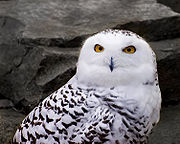
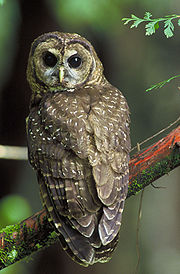
Family Strigidae
- Flammulated OwlFlammulated OwlThe Flammulated Owl is a small, nocturnal owl approximately 15 cm long with a 36 cm wingspan. Males and females can be distinguished by their weight. Females are larger, ranging from 62-65 grams and males are smaller ranging from 50-52 grams. The owl gets the name flammulated from the flame...
Otus flammeolus - Western Screech-Owl Megascops kennicottii
- Great Horned OwlGreat Horned OwlThe Great Horned Owl, , also known as the Tiger Owl, is a large owl native to the Americas. It is an adaptable bird with a vast range and is the most widely distributed true owl in the Americas.-Description:...
Bubo virginianus - Snowy OwlSnowy OwlThe Snowy Owl is a large owl of the typical owl family Strigidae. The Snowy Owl was first classified in 1758 by Carolus Linnaeus, the Swedish naturalist who developed binomial nomenclature to classify and organize plants and animals. The bird is also known in North America as the Arctic Owl, Great...
Bubo scandiacus - Northern Hawk OwlNorthern Hawk OwlThe Northern Hawk-Owl is a non-migratory owl that usually stays within its breeding range. It sometimes irrupts southward.-General:It is the only living species in the genus Surnia...
Surnia ulula - Northern Pygmy-Owl Glaucidium gnoma
- Burrowing OwlBurrowing OwlThe Burrowing Owl is a tiny but long-legged owl found throughout open landscapes of North and South America. Burrowing Owls can be found in grasslands, rangelands, agricultural areas, deserts, or any other open dry area with low vegetation. They nest and roost in burrows, such as those excavated...
Athene cunicularia - Spotted OwlSpotted OwlThe Spotted Owl, Strix occidentalis, is a species of true owl. It is a resident species of forests in western North America, where it nests in tree holes, old bird of prey nests, or rock crevices. Nests can be between 13 and 66 yards high and usually contain two eggs...
Strix occidentalis - Barred OwlBarred OwlThe Barred Owl is a large typical owl. It goes by many other names, including eight hooter, rain owl, wood owl, and striped owl, but is probably best known as the hoot owl.-Description:...
Strix varia - Great Gray Owl Strix nebulosa
- Long-eared OwlLong-eared OwlThe Long-eared Owl - Asio otus is a species of owl which breeds in Europe, Asia, and North America. This species is a part of the larger grouping of owls known as typical owls, family Strigidae, which contains most species of owl...
Asio otus - Short-eared OwlShort-eared OwlThe Short-eared Owl is a species of typical owl . In Scotland this species of owl is often referred to as a cataface, grass owl or short-horned hootlet. Owls belonging to genus Asio are known as the eared owls, as they have tufts of feathers resembling mammalian ears. These "ear" tufts may or may...
Asio flammeus - Boreal Owl Aegolius funereus
- Northern Saw-whet OwlNorthern Saw-whet OwlThe Northern Saw-whet Owl is a small owl native to North America.-Description:The scientific description of one of the sub-species of this owl is attributed to the Rev. John Henry Keen who was a missionary in Canada in 1896. Adults are long with a wingspan. They can weigh from with an average...
Aegolius acadicus
Family Caprimulgidae
Subfamily Chordeilinae- Common NighthawkCommon NighthawkThe Common Nighthawk is a medium-sized crepuscular or nocturnal bird, whose presence and identity are best revealed by its vocalization. Typically dark , displaying cryptic colouration and intricate patterns, this bird becomes invisible by day. Once aerial, with its buoyant but erratic flight,...
Chordeiles minor
Subfamily Caprimulginae
- Common PoorwillCommon PoorwillThe Common Poorwill is a nocturnal bird of the family Caprimulgidae, the nightjars. It is found from British Columbia and southeastern Alberta, through the western United States to northern Mexico...
Phalaenoptilus nuttallii - Whip-poor-willWhip-poor-willThe Eastern Whip-poor-will, Caprimulgus vociferus, is a medium-sized nightjar from North and Central America. The whip-poor-will is commonly heard within its range, but less often seen because of its superior camouflage...
Caprimulgus vociferus
Family Apodidae
Subfamily Cypseloidinae- Black SwiftBlack SwiftThe American Black Swift or more simply Black Swift is found from northern British Columbia in Canada through the United States and Mexico to Costa Rica. It is also found on islands in the West Indies....
Cypseloides niger
Subfamily Chaeturinae
- Vaux's SwiftVaux's SwiftVaux's Swift is a small swift native to North America and northern South America. It was named for the American scientist William Sansom Vaux.-Description:...
Chaetura vauxi
Subfamily Apodinae
- White-throated SwiftWhite-throated SwiftThe White-throated Swift is a swift of the family Apodidae native to western North America, south to cordilleran western Honduras...
Aeronautes saxatalis
Family Trochilidae
Subfamily Trochilinae- Broad-billed HummingbirdBroad-billed HummingbirdThe Broad-billed Hummingbird, Cynanthus latirostris, is a medium-sized hummingbird. It is 9–10 cm long, and weighs approximately three to four grams....
Cynanthus latirostris - Ruby-throated HummingbirdRuby-throated HummingbirdThe Ruby-throated Hummingbird , is a small hummingbird. It is the only species of hummingbird that regularly nests east of the Mississippi River in North America.- Description :...
Archilochus colubris - Black-chinned HummingbirdBlack-chinned HummingbirdThe Black-chinned Hummingbird is a small hummingbird.Adults are metallic green above and white below with green flanks. Their bill is long, straight and very slender. The adult male has a black face and chin, a glossy purple throat band and a dark forked tail...
Archilochus alexandri - Anna's HummingbirdAnna's HummingbirdAnna's Hummingbird is a medium-sized hummingbird native to the west coast of North America. This bird was named after Anna Masséna, Duchess of Rivoli.-Description:...
Calypte anna - Costa's HummingbirdCosta's HummingbirdThe Costa's Hummingbird is a species of hummingbird.The Costa's Hummingbird is very small, a mature adult growing to only 3 to 3½ inches in length. The male Costa's has a mainly green back and flanks, a small black tail and wings, and patches of white below their gorgeted throat and tail...
Calypte costae - Calliope HummingbirdCalliope HummingbirdThe Calliope Hummingbird is a very small hummingbird and the smallest bird found in Canada and the United States. It is the only member of the Stellula genus....
Stellula calliope - Broad-tailed HummingbirdBroad-tailed HummingbirdThe Broad-tailed hummingbird, Selasphorus platycercus, is a medium-sized hummingbird, nearly in length.Male and female both have iridescent green backs and crowns and a white breast. The male has a gorget that shines with a brilliant red iridescence...
Selasphorus platycercus - Rufous HummingbirdRufous HummingbirdThe Rufous Hummingbird is a small hummingbird, about 8 cm long with a long, straight and very slender bill. The female is slightly larger than the male.-Description:...
Selasphorus rufus - Allen's HummingbirdAllen's HummingbirdThe Allen's Hummingbird, Selasphorus sasin, is a species of hummingbird.The Allen's Hummingbird is a small bird, with mature adults reaching only 3 to 3½ inches in length. The male Allen's has a green back and forehead, with rust-colored rufous flanks, rump, and tail. The male's throat is also an...
Selasphorus sasin
Order PiciformesPiciformesNine families of largely arboreal birds make up the order Piciformes, the best-known of them being the Picidae, which includes the woodpeckers and close relatives...
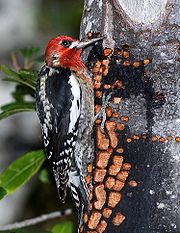
Family PicidaePicidaeThe woodpeckers, piculets and wrynecks are a family, Picidae, of near-passerine birds. Members of this family are found worldwide, except for Australia and New Zealand, Madagascar, and the extreme polar regions...
Subfamily Picinae
- Lewis's WoodpeckerLewis's WoodpeckerThe Lewis's Woodpecker, Melanerpes lewis, is a large North American species of woodpecker which was named for Meriwether Lewis, one of the explorers who surveyed the areas bought by the United States of America during the Louisiana Purchase.-Description:...
Melanerpes lewis - Red-headed WoodpeckerRed-headed WoodpeckerThe Red-headed Woodpecker, Melanerpes erythrocephalus, is a small or medium-sized woodpecker from temperate North America. Their breeding habitat is open country across southern Canada and the eastern-central United States.-Taxonomy:...
Melanerpes erythrocephalus - Acorn WoodpeckerAcorn WoodpeckerThe Acorn woodpecker is a medium-sized woodpecker, 21 cm long with an average weight of 85 g.-Description:...
Melanerpes formicivorus - Williamson's SapsuckerWilliamson's SapsuckerWilliamson's Sapsucker, Sphyrapicus thyroideus, is a medium-sized woodpecker belonging to the genus Sphyrapicus .-Habitat and range:...
Sphyrapicus thyroideus - Yellow-bellied SapsuckerYellow-bellied SapsuckerThe Yellow-bellied Sapsucker is a medium-sized woodpecker found in North America, Central America and the Caribbean.-Taxonomy:...
Sphyrapicus varius - Red-naped SapsuckerRed-naped SapsuckerThe Red-naped Sapsucker is a medium-sized woodpecker.-Habitat:Their breeding habitat is mixed forests in the Rocky Mountains and Great Basin areas of North America. They nest in a cavity in a dead tree. Other species which nest in tree cavities reuse nests formerly used by these...
Sphyrapicus nuchalis - Red-breasted SapsuckerRed-breasted SapsuckerThe Red-breasted Sapsucker , is a medium-sized woodpecker of the forests of the west coast of North America.-Description:...
Sphyrapicus ruber - Nuttall's WoodpeckerNuttall's WoodpeckerNuttall's Woodpecker, Picoides nuttallii, is a species of woodpecker named after naturalist Thomas Nuttall in 1843. They are found in oak woodlands of California and are similar to the Ladder-backed Woodpecker in terms of genetics and in appearance. -Description:Nuttall’s Woodpecker has black...
Picoides nuttallii - Downy WoodpeckerDowny WoodpeckerThe Downy Woodpecker is a species of woodpecker, the smallest in North America.- Description :Adult Downy Woodpeckers are mainly black on the upperparts and wings, with a white back, throat and belly and white spotting on the wings. There is a white bar above the eye and one below. They have a...
Picoides pubescens - Hairy WoodpeckerHairy WoodpeckerThe Hairy Woodpecker is a medium-sized woodpecker, averaging approximately 250 mm in length with a 380 mm wingspan...
Picoides villosus - White-headed WoodpeckerWhite-headed WoodpeckerThe White-headed Woodpecker is a non-migratory woodpecker that resides in pine forests of the mountains of western North America. It has a black body and white head. It has white primary feathers that form a crescent in flight...
Picoides albolarvatus - American Three-toed WoodpeckerAmerican Three-toed WoodpeckerThe American Three-toed woodpecker, Picoides dorsalis is a medium-sized woodpecker .This woodpecker has a length of 21 cm and a wingspan of 38 cm and closely resembles the Black-backed Woodpecker, which is also three-toed. Until recently, it was considered to be the same species as the Eurasian...
Picoides dorsalis - Black-backed WoodpeckerBlack-backed WoodpeckerThe Black-backed Woodpecker also known as the Arctic Three-toed Woodpecker is a medium-sized woodpecker inhabiting the forests of North America. It is a medium sized woodpecker ....
Picoides arcticus - Northern FlickerNorthern FlickerThe Northern Flicker is a medium-sized member of the woodpecker family. It is native to most of North America, parts of Central America, Cuba, the Cayman Islands, and is one of the few woodpecker species that migrate. There are over 100 common names for the Northern Flicker...
Colaptes auratus - Pileated WoodpeckerPileated WoodpeckerThe Pileated Woodpecker is a very large North American woodpecker, almost crow-sized, inhabiting deciduous forests in eastern North America, the Great Lakes, the boreal forests of Canada, and parts of the Pacific coast. It is also the largest woodpecker in America.Adults are long, and weigh...
Dryocopus pileatus
Order Passeriformes
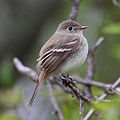

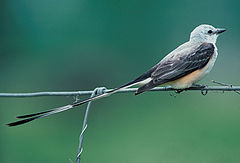
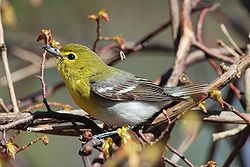


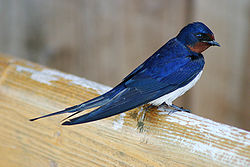


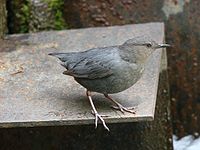
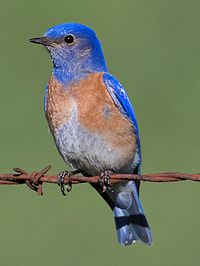
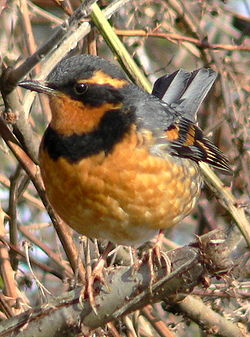
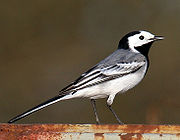
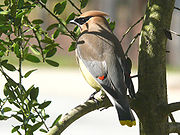
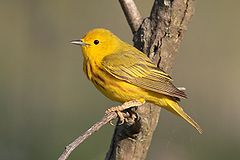

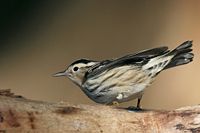
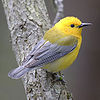
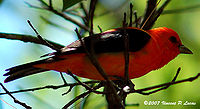
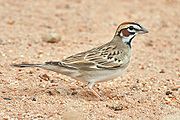
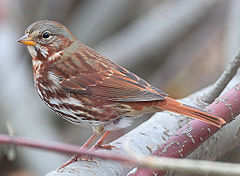

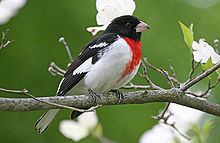
Family Tyrannidae
Subfamily Fluvicolinae- Olive-sided FlycatcherOlive-sided FlycatcherThe Olive-sided Flycatcher, Contopus cooperi, is a passerine bird. It is a medium-sized tyrant flycatcher.- Description :Adults are dark olive on the face, upperparts and flanks. They have light underparts, a large dark bill and a short tail....
Contopus cooperi - Western Wood-Pewee Contopus sordidulus
- Eastern Wood-Pewee Contopus virens
- Alder FlycatcherAlder FlycatcherThe Alder Flycatcher, Empidonax alnorum, is a small insect-eating bird of the tyrant flycatcher family.Adults have olive-brown upperparts, browner on the wings and tail, with whitish underparts; they have a white eye ring, white wing bars, a small bill and a short tail. The breast is washed with...
Empidonax alnorum - Willow FlycatcherWillow FlycatcherThe Willow Flycatcher is a small insect-eating bird of the tyrant flycatcher family.Adults have brown-olive upperparts, darker on the wings and tail, with whitish underparts; they have an indistinct white eye ring, white wing bars and a small bill. The breast is washed with olive-grey. The upper...
Empidonax traillii - Least FlycatcherLeast FlycatcherThe Least Flycatcher , , is a small insect-eating bird...
Empidonax minimus - Hammond's FlycatcherHammond's FlycatcherHammond's Flycatcher, Empidonax hammondii is a small insect-eating bird. It is a small Empidonax flycatcher, with typical size ranging from 12.5-14.5 cm....
Empidonax hammondii - Gray FlycatcherGray FlycatcherThe American Gray Flycatcher, or just Gray Flycatcher, is a small, insectivorous passerine in the tyrant flycatcher family. It is common in the arid regions of western North America, especially the Great Basin...
Empidonax wrightii - Dusky FlycatcherDusky FlycatcherThe American Dusky Flycatcher, or simply Dusky Flycatcher, is a small, insectivorous passerine of the tyrant flycatcher family....
Empidonax oberholseri - Pacific-slope FlycatcherPacific-slope FlycatcherThe Pacific-slope Flycatcher is a small insectivorous bird of the family Tyrannidae. It is native to coastal regions of western North America, including the Pacific Ocean and the southern Sea of Cortez, as far north as British Columbia and southern Alaska, but is replaced in the inland regions by...
Empidonax difficilis - Cordilleran FlycatcherCordilleran FlycatcherThe Cordilleran Flycatcher, Empidonax occidentalis, is a small insect-eating bird. It is a small Empidonax flycatcher, with typical length ranging from 13 to 17 cm....
Empidonax occidentalis - Black PhoebeBlack PhoebeThe Black Phoebe, Sayornis nigricans, is a passerine bird in the tyrant-flycatcher family. It breeds from southwest Oregon and California south through Central and South America. It occurs year-round throughout most of its range and migrates less than the other birds in its genus, though its...
Sayornis nigricans - Eastern PhoebeEastern PhoebeThe Eastern Phoebe is a small passerine bird. This tyrant flycatcher breeds in eastern North America, although its normal range does not include the southeastern coastal USA....
Sayornis phoebe - Say's PhoebeSay's PhoebeThe Say's Phoebe is a passerine bird in the tyrant flycatcher family.Adults have brownish-gray upperparts with an orange-brown belly and light gray on the throat and breast. Juveniles have cinnamon wing bars; adults have no wing bars....
Sayornis saya - Vermilion FlycatcherVermilion FlycatcherThe Vermilion Flycatcher is a small passerine bird in the Tyrannidae, or tyrant flycatcher family. Most flycatchers are rather drab, but the Vermilion Flycatcher is a striking exception...
Pyrocephalus rubinus
Subfamily Tyranninae
- Dusky-capped FlycatcherDusky-capped FlycatcherThe Dusky-capped Flycatcher, Myiarchus tuberculifer, is a passerine bird in the tyrant flycatcher family. It breeds in forest and other woodland from southern Arizona, as well as the Chisos Mountains, Texas, south to northern Argentina and on Trinidad...
Myiarchus tuberculifer - Ash-throated FlycatcherAsh-throated FlycatcherThe Ash-throated Flycatcher, Myiarchus cinerascens, is a passerine bird in the tyrant flycatcher family. It breeds in desert scrub, riparian forest, brushy pastures and open woodland from the western United States to central Mexico. It is a short-distance migrant, retreating from most of the U.S....
Myiarchus cinerascens - Tropical KingbirdTropical KingbirdThe Tropical Kingbird is a large tyrant flycatcher. This bird breeds from southern Arizona and the lower Rio Grande Valley of Texas in the USA through Central America, South America as far as south as central Argentina and western Peru, and on Trinidad and Tobago...
Tyrannus melancholicus - Cassin's KingbirdCassin's KingbirdThe Cassin's Kingbird, Tyrannus vociferans, is a large Tyrant flycatcher.Adults have a gray head with slightly darker cheeks; a dark unforked tail with a buffy fringe and gray-olive underparts.They have a pale throat and deep yellow lower breast....
Tyrannus vociferans - Western KingbirdWestern KingbirdThe Western Kingbird is a large tyrant flycatcher.Adults are grey-olive on the upperparts with a grey head and a dark line through the eyes; the underparts are light becoming light orange-yellow on the lower breast and belly. They have a long black tail with white outer feathers...
Tyrannus verticalis - Eastern KingbirdEastern KingbirdThe Eastern Kingbird, Tyrannus tyrannus, is a large Tyrant flycatcher.Adults are grey-black on the upperparts with light underparts; they have a long black tail with a white end and long pointed wings. They have a red patch on their crown, seldom seen...
Tyrannus tyrannus - Scissor-tailed FlycatcherScissor-tailed FlycatcherThe Scissor-tailed Flycatcher is a long-tailed insectivorous bird of the genus, whose members are collectively referred to as kingbirds. The kingbirds are a group of large insectivorous birds in the tyrant flycatcher family...
Tyrannus forficatus
Family Laniidae
- Loggerhead ShrikeLoggerhead ShrikeThe Loggerhead Shrike is a passerine bird. It is the only member of the shrike family endemic to North America; the related Northern Shrike occurs north of its range but also in the Palearctic....
Lanius ludovicianus - Northern Shrike Lanius excubitor
Family Vireonidae
- Bell's VireoBell's VireoThe Bell's Vireo is a small North American songbird. It is 4-3/4 to 5 inches in length, dull olive-gray above and whitish below...
Vireo bellii - Yellow-throated VireoYellow-throated VireoThe Yellow-throated Vireo, Vireo flavifrons, is a small American songbird.Adults are mainly olive on the head and upperparts with a yellow throat and white belly; they have dark eyes with yellow "spectacles". The tail and wings are dark with white wing bars...
Vireo flavifrons - Plumbeous VireoPlumbeous VireoThe Plumbeous Vireo is a small North American songbird, ranging from far southeastern Montana and western South Dakota south to the Pacific coast of Mexico, including the extreme southern regions of Baja California Sur...
Vireo plumbeus - Cassin's VireoCassin's VireoCassin's Vireo is a small North American songbird, ranging from southern British Columbia in Canada through the western coastal states of the United States. This bird migrates, spending the winter from southern Arizona to southern Mexico.The vireo is 11–14 cm in length, with a gray head, back,...
Vireo cassinii - Blue-headed VireoBlue-headed VireoThe Blue-headed Vireo is a Neotropical migrating song bird found in North and Central America. There are currently two recognized sub-species that belong to the Blue-headed Vireo. It has a range that extends across Canada and the eastern coast of the United-States, Mexico and some of Central America...
Vireo solitarius - Hutton's VireoHutton's VireoHutton's Vireo is a small songbird. It is approximately 5 inches in length, dull olive-gray above and below. It has a faint white eye ring and faint white wing bars. It closely resembles a Ruby-crowned Kinglet, but has a thicker bill and is slightly larger in size. Its most common song is a...
Vireo huttoni - Warbling VireoWarbling VireoThe Warbling Vireo, Vireo gilvus, is a small North American songbird.Its breeding habitat is open deciduous and mixed woods from Alaska to Mexico and the Florida Panhandle. It often nests along streams. It migrates to Mexico and Central America....
Vireo gilvus - Philadelphia VireoPhiladelphia VireoThe Philadelphia Vireo, Vireo philadelphicus, is a small songbird.Adults are mainly olive-brown on the upperparts with yellow underparts; they have dark eyes and a grey crown. There is a dark line through the eyes and a white stripe just over them. They have thick blue-grey legs and a stout...
Vireo philadelphicus - Red-eyed VireoRed-eyed VireoThe Red-eyed Vireo, Vireo olivaceus, is a small American songbird, 13–14 cm in length. It is somewhat warbler-like but not closely related to the New World warblers...
Vireo olivaceus
Family Corvidae
- Gray JayGray JayThe Gray Jay , also Grey Jay, Canada Jay, or Whiskey Jack, is a member of the crow and jay family found in the boreal forests across North America north to the tree-line and in subalpine forests of the Rocky Mountains south to New Mexico and Arizona...
Perisoreus canadensis - Steller's JaySteller's JayThe Steller's Jay is a jay native to western North America, closely related to the Blue Jay found in the rest of the continent, but with a black head and upper body. It is also known as the Long-crested Jay, Mountain Jay, and Pine Jay...
Cyanocitta stelleri - Blue JayBlue JayThe Blue Jay is a passerine bird in the family Corvidae, native to North America. It is resident through most of eastern and central United States and southern Canada, although western populations may be migratory. It breeds in both deciduous and coniferous forests, and is common near and in...
Cyanocitta cristata - Western Scrub-Jay Aphelocoma californica
- Pinyon JayPinyon JayThe Pinyon Jay is a jay between the North American Blue Jay and the Eurasian Jay in size. It is the only member of the genus Gymnorhinus, . Its overall proportions are very Nutcracker-like and indeed this can be seen as convergent evolution as both birds fill similar ecological niches...
Gymnorhinus cyanocephalus - Clark's NutcrackerClark's NutcrackerClark's Nutcracker , sometimes referred to as Clark's Crow or Woodpecker Crow, is a passerine bird in the family Corvidae. It is slightly smaller than its Eurasian relative the Spotted Nutcracker . It is ashy-grey all over except for the black-and-white wings and central tail feathers...
Nucifraga columbiana - Black-billed MagpieBlack-billed MagpieThe Black-billed Magpie is a bird in the crow family that inhabits the western half of North America. It is notable for its domed nests, and for being one of only four North American songbirds whose tail makes up half or more of the total body length The Black-billed Magpie (Pica hudsonia) is a...
Pica hudsonia - American CrowAmerican CrowThe American Crow is a large passerine bird species of the family Corvidae. It is a common bird found throughout much of North America...
Corvus brachyrhynchos - Common RavenCommon RavenThe Common Raven , also known as the Northern Raven, is a large, all-black passerine bird. Found across the northern hemisphere, it is the most widely distributed of all corvids...
Corvus corax
Family Hirundinidae
Subfamily Hirundininae- Purple MartinPurple MartinThe Purple Martin is the largest North American swallow. These aerial acrobats have speed and agility in flight, and when approaching their housing, will dive from the sky at great speeds with their wings tucked.-Description and taxonomy:...
Progne subis - Tree SwallowTree SwallowThe Tree Swallow, Tachycineta bicolor, is a migratory passerine bird that breeds in North America and winters in Mexico, Central America and the Caribbean. It is a very rare vagrant to western Europe....
Tachycineta bicolor - Violet-green SwallowViolet-green SwallowThe Violet-green Swallow, Tachycineta thalassina, is a small North American swallow.Their breeding habitat is semi-open areas in western North America from Alaska to Mexico...
Tachycineta thalassina - Northern Rough-winged SwallowNorthern Rough-winged SwallowThe Northern Rough-winged Swallow is a small swallow.Adults are 13–15 cm in length, brown on top with light underparts and a forked tail. They are similar in appearance to the Bank Swallow but have a dusky throat and breast...
Stelgidopteryx serripennis - Bank Swallow Riparia riparia
- Cliff SwallowCliff SwallowThe Cliff Swallow is a member of the passerine bird family Hirundinidae — the swallows and martins.It breeds in North America, and is migratory, wintering in western South America from Venezuela southwards to northeast Argentina...
Petrochelidon pyrrhonota - Barn SwallowBarn SwallowThe Barn Swallow is the most widespread species of swallow in the world. It is a distinctive passerine bird with blue upperparts, a long, deeply forked tail and curved, pointed wings. It is found in Europe, Asia, Africa and the Americas...
Hirundo rustica
Family Paridae
- Black-capped ChickadeeBlack-capped ChickadeeThe Black-capped Chickadee is a small, North American songbird, a passerine bird in the tit family Paridae. It is the state bird of both Maine and Massachusetts in the United States, and the provincial bird of New Brunswick in Canada...
Poecile atricapillus - Mountain ChickadeeMountain ChickadeeThe Mountain Chickadee is a small songbird, a passerine bird in the tit family Paridae. Often, it is still placed in the genus Parus with most other tits, but mtDNA cytochrome b sequence data and morphology suggest that separating Poecile more adequately expresses these birds' relationships...
Poecile gambeli - Chestnut-backed ChickadeeChestnut-backed ChickadeeThe Chestnut-backed Chickadee is a small passerine bird in the tit family, Paridae....
Poecile rufescens - Oak TitmouseOak TitmouseThe Oak Titmouse, Baeolophus inornatus, is a passerine bird in the tit family Paridae. The American Ornithologists' Union split the Plain Titmouse into the Oak Titmouse and the Juniper Titmouse in 1996, due to distinct differences in song, preferred habitat, and genetic makeup.The Oak Titmouse is a...
Baeolophus inornatus - Juniper TitmouseJuniper TitmouseThe Juniper Titmouse, Baeolophus ridgwayi, is a passerine bird in the tit family Paridae. The American Ornithologists' Union split the Plain Titmouse into the Oak Titmouse and the Juniper Titmouse in 1996, due to distinct differences in song, preferred habitat, and genetic makeup.The Juniper...
Baeolophus ridgwayi
Family SittidaeSittidaeSittidae is a family of small passerine birds which contains the single genus Sitta containing about 24 species of nuthatches, which are found across Eurasia and North America....
Subfamily Sittinae
- Red-breasted NuthatchRed-breasted NuthatchThe Red-breasted Nuthatch, Sitta canadensis, is a small songbird. The adult has blue-grey upperparts with cinnamon underparts, a white throat and face with a black stripe through the eyes, a straight grey bill and a black crown. Its call, which has been likened to a tin trumpet, is high-pitched...
Sitta canadensis - White-breasted NuthatchWhite-breasted NuthatchThe White-breasted Nuthatch is a small songbird of the nuthatch family which breeds in old-growth woodland across much of temperate North America. It is a stocky bird, with a large head, short tail, powerful bill and strong feet. The upperparts are pale blue-gray, and the face and underparts are...
Sitta carolinensis - Pygmy NuthatchPygmy NuthatchThe Pygmy Nuthatch is a tiny songbird, about 10 cm long and about 10 grams in weight. It ranges from southern British Columbia south through various discontinuous parts of the western U.S. , to central Mexico...
Sitta pygmaea
Family Troglodytidae
- Rock WrenRock WrenThe Rock Wren is a small songbird of the wren family. It is the only species in the genus Salpinctes.The 12 cm long adults have grey-brown upperparts with small black and white spots and pale grey underparts with a light brown rump...
Salpinctes obsoletus - Canyon WrenCanyon WrenThe Canyon Wren is a small North American wren, and is about 14.5 cm long. It ranges from far southern British Columbia and Montana south through much of Mexico to western Chiapas and east to Oklahoma and Texas...
Catherpes mexicanus - Bewick's WrenBewick's WrenThe Bewick's Wren is a wren native to North America. At about 14 cm long, it is grey-brown above, white below, with a long white eyebrow. While similar in appearance to the Carolina Wren, it has a long tail that is tipped in white. The song is loud and melodious, much like the song of other...
Thryomanes bewickii - House WrenHouse WrenThe House Wren, Troglodytes aedon, is a very small songbird of the wren family, Troglodytidae. It occurs from Canada to southernmost South America, and is thus the most widely distributed bird in the Americas. It occurs in most suburban areas in its range and it is the single most common wren...
Troglodytes aedon - Winter WrenWinter WrenThe Winter Wren is a very small North American bird and a member of the mainly New World wren family Troglodytidae. It was once lumped with Troglodytes pacificus of western North America and Troglodytes troglodytes of Eurasia under the name Winter Wren.It breeds in coniferous forests from British...
Troglodytes troglodytes - Sedge WrenSedge WrenThe Sedge Wren, Cistothorus platensis, is a small songbird of the Wren family. It was formerly known as the Short-billed Marsh Wren, and in South America is known as the Grass Wren. There are about 20 different subspecies which are found across most of the Americas...
Cistothorus platensis - Marsh WrenMarsh WrenThe Marsh Wren is a small North American songbird of the wren family. It is sometimes called Long-billed Marsh Wren to distinguish it from the Sedge Wren, also known as Short-billed Marsh Wren....
Cistothorus palustris
Family Regulidae
- Golden-crowned KingletGolden-crowned KingletThe Golden-crowned Kinglet, Regulus satrapa, is a very small songbird.Adults are olive-gray on the upperparts with white underparts, with thin bills and short tails. They have white wing bars, a black stripe through the eyes and a yellow crown surrounded by black...
Regulus satrapa - Ruby-crowned Kinglet Regulus calendula
Family SylviidaeSylviidaeSylviidae is a family of passerine birds that was part of an assemblage known as the Old World warblers. The family was formerly a wastebin taxon with over 400 species of bird in over 70 genera. The family was poorly defined with many characteristics shared with other families...
Subfamily Polioptilinae
- Blue-gray GnatcatcherBlue-gray GnatcatcherThe Blue-gray Gnatcatcher, Polioptila caerulea, is a very small songbird.Adult males are blue-grey on the upperparts with white underparts and have a long slender bill, long black tail and an angry black unibrow. Females are less blue without the unibrow...
Polioptila caerulea
Family Turdidae
- Northern WheatearNorthern WheatearThe Northern Wheatear or Wheatear is a small passerine bird that was formerly classed as a member of the thrush family Turdidae, but is now more generally considered to be an Old World flycatcher, Muscicapidae...
Oenanthe oenanthe - Western BluebirdWestern BluebirdThe Western Bluebird is a small thrush, approximately to in length.Adult males are bright blue on top and on the throat with an orange breast and sides, a brownish patch on back, and a gray belly and undertail coverts. Adult females have a duller blue body, wings, and tail than the male, a gray...
Sialia mexicana - Mountain BluebirdMountain BluebirdThe Mountain Bluebird is a medium-sized bird weighing about 2-5 ounces, with a length from 15–20 cm . They have light underbellies and black eyes. Adult males have thin bills are bright turquoise-blue and somewhat lighter beneath. Adult females have duller blue wings and tail, grey breast,...
Sialia currucoides - Townsend's SolitaireTownsend's SolitaireTownsend's Solitaire is a medium-sized thrush, the only solitaire native to America north of Mexico.-Range and habitat:...
Myadestes townsendi - VeeryVeeryThe Veery, Catharus fuscescens, is a small thrush species. It is occasionally called Willow Thrush or Wilson's Thrush. It is a member of a close-knit group of migrant Catharus species, which also includes the cryptotaxa Grey-cheeked Thrush and Bicknell's Thrush The Veery, Catharus fuscescens, is a...
Catharus fuscescens - Gray-cheeked ThrushGray-cheeked ThrushThe Grey-cheeked Thrush, Catharus minimus, is a medium-sized thrush. This species is 15–17 cm in length, and has the white-dark-white underwing pattern characteristic of Catharus thrushes. It is a member of a close-knit group of migrant species together with the Veery and Bicknell's Thrush ;...
Catharus minimus - Swainson's ThrushSwainson's ThrushSwainson's Thrush , also called Olive-backed Thrush, is a medium-sized thrush. This species is 16–18 cm in length, and has the white-dark-white underwing pattern characteristic of Catharus thrushes...
Catharus ustulatus - Hermit ThrushHermit ThrushThe Hermit Thrush is a medium-sized North American thrush. It is not very closely related to the other North American migrant species of Catharus, but rather to the Mexican Russet Nightingale-thrush.-Description:...
Catharus guttatus - Wood ThrushWood ThrushThe Wood Thrush, Hylocichla mustelina, is a North American passerine bird. It is closely related to other thrushes such as the American Robin and is widely distributed across North America, wintering in Central America and southern Mexico...
Hylocichla mustelina - American RobinAmerican RobinThe American Robin or North American Robin is a migratory songbird of the thrush family. It is named after the European Robin because of its reddish-orange breast, though the two species are not closely related, with the European robin belonging to the flycatcher family...
Turdus migratorius - Varied ThrushVaried ThrushThe Varied Thrush is a member of the thrush family Turdidae.It breeds in western North America from Alaska to northern California. It is migratory, with northern breeders moving south within or somewhat beyond the breeding range...
Ixoreus naevius
Family Mimidae
- Gray CatbirdGray CatbirdThe Gray Catbird , also spelled Grey Catbird, is a medium-sized northern American perching bird of the mimid family. It is the only member of the "catbird" genus Dumetella...
Dumetella carolinensis - Northern MockingbirdNorthern MockingbirdThe Northern Mockingbird, Mimus polyglottos, is the only mockingbird commonly found in North America. This species was first described by Linnaeus in his Systema naturae in 1758 as Turdus polyglottos....
Mimus polyglottos - Sage ThrasherSage ThrasherThe Sage Thrasher is a medium-sized passerine bird from the family Mimidae, which also includes mockingbirds, tremblers and New World catbirds. It is the only member of the genus Oreoscoptes. This seems less close to the Caribbean thrashers, but rather to the mockingbirds instead .O...
Oreoscoptes montanus - Brown ThrasherBrown ThrasherThe Brown Thrasher , sometimes erroneously called the Brown Thrush, is a bird in the Mimidae family, a group that also includes the New World catbirds and mockingbirds.-Description:...
Toxostoma rufum - Curve-billed ThrasherCurve-billed ThrasherThe Curve-billed Thrasher is a perching bird of the thrasher group native to the southwestern United States and much of Mexico....
Toxostoma curvirostre - California ThrasherCalifornia ThrasherThe California Thrasher is a large thrasher found primarily in chaparral habitat in California and Baja California. Similar to the Crissal and Le Conte's Thrashers in habit, the California Thrasher is the only species of Toxostoma throughout most of its limited range...
Toxostoma redivivum
Family MotacillidaeMotacillidaeThe Motacillidae are a family of small passerine birds with medium to long tails. There are around 65 species in 6 genera and they include the wagtails, longclaws and pipits. The longclaws are entirely restricted to the Afrotropics, and the wagtails are predominately found in Europe, Africa and...
- Eastern Yellow Wagtail Motacilla tschutschensis
- White WagtailWhite Wagtail"Pied Wagtail" redirects here. For the related African bird, see African Pied Wagtail.The White Wagtail is a small passerine bird in the wagtail family Motacillidae, which also includes the pipits and longclaws. This species breeds in much of Europe and Asia and parts of north Africa...
Montacilla alba - Red-throated PipitRed-throated PipitThe Red-throated Pipit is a small passerine bird which breeds in the far north of Europe and Asia, with a foothold in northern Alaska. It is a long-distance migrant moving in winter to Africa, south and east Asia and west coast USA...
Anthus cervinus - American Pipit Anthus rubescens
- Sprague's PipitSprague's PipitSprague's Pipit is a small passerine bird that breeds in the short and mixed-grass prairies of North America and overwinters in the southwestern United States and northern Mexico. Easiest to identify by the distinctive descending call that is delivered in the breeding season from a considerable...
Anthus spragueii
Family Bombycillidae
- Bohemian WaxwingBohemian WaxwingThe Bohemian Waxwing is a member of the waxwing family of passerines. A sleek bird, 18–21 cm long with a pointed crest, it travels in large, nomadic groups with a strong, direct flight. It breeds in coniferous forests throughout the most northern parts of Europe, Asia and western North America...
Bombycilla garrulus - Cedar WaxwingCedar WaxwingThe Cedar Waxwing is a member of the family Bombycillidae or waxwing family of passerine birds. It breeds in open wooded areas in North America, principally southern Canada and the northern United States.-Description:...
Bombycilla cedrorum
Family Parulidae
- Blue-winged WarblerBlue-winged WarblerThe Blue-winged Warbler, Vermivora cyanoptera, is a fairly common New World warbler, 11.5 cm long and weighing 8.5 g. It breeds in eastern North America in southern Ontario and the eastern USA. Its range is extending northwards, where it is replacing the very closely related...
Vermivora pinus - Golden-winged WarblerGolden-winged WarblerThe Golden-winged Warbler, Vermivora chrysoptera, is a New World warbler, 11.6 cm long and weighing 8.5 g. It breeds in eastern North America, southeastern Canada and the eastern USA...
Vermivora chrysoptera - Tennessee WarblerTennessee WarblerThe Tennessee Warbler, Oreothlypis peregrina, is a New World warbler. It breeds in northern North America across Canada and the northern USA. It is migratory, wintering in southern Central America and northern Colombia and Venezuela, with a few stragglers going as far south as Ecuador. It is a...
Vermivora peregrina - Orange-crowned WarblerOrange-crowned WarblerThe Orange-crowned Warbler is a small songbird of the New World warbler family.These birds are distinguished by their lack of wing bars, streaking on the underparts, strong face marking or bright colouring, resembling a fall Tennessee Warbler. The orange patch on the crown is usually not visible...
Vermivora celata - Nashville WarblerNashville WarblerThe Nashville Warbler, Vermivora ruficapilla, is a small songbird in the New World warbler family.They have olive-brown upperparts, a white belly and a yellow throat and breast; they have a white eye ring, no wing bars and a thin pointed bill. Adult males have a grey head with a rusty crown patch ;...
Vermivora ruficapilla - Virginia's WarblerVirginia's WarblerVirginia's Warbler is a species of New World warbler.Despite what its name may suggest, Virginia's warbler is not actually named after the American State of Virginia, which makes sense as the birds range only reaches as far east as the state of Texas...
Vermivora virginiae - Lucy's WarblerLucy's WarblerLucy's Warbler, Oreothlypis luciae, is the smallest New World warbler found in North America, measuring a mere 4.25 inches in length....
Vermivora luciae - Northern ParulaNorthern ParulaThe Northern Parula, Parula americana, is a small New World warbler. It breeds in eastern North America from southern Canada to Florida....
Parula americana - Yellow WarblerYellow WarblerDendroica petechia is a New World warbler species or superspecies; the subspecies group around D. aestiva is increasingly treated as good species Dendroica aestiva again. The name for the entire cryptic species complex is Mangrove Warbler, and another group of subspecies is known as Golden Warbler...
Dendroica petechia - Chestnut-sided WarblerChestnut-sided WarblerThe Chestnut-sided Warbler is a New World warbler. They breed in eastern North America and in southern Canada westwards to the Canadian Prairies...
Dendroica pensylvanica - Magnolia WarblerMagnolia WarblerSetophaga magnolia, commonly known as the Magnolia warbler, is a member of the Parulidae family of wood warblers. [4] This warbler was first discovered in magnolia trees in the 19th century by famed ornithologist Alexander Wilson while in Mississippi. [7]-Description:The magnolia warbler can be...
Dendroica magnolia - Cape May WarblerCape May WarblerThe Cape May Warbler, Dendroica tigrina, is a small New World warbler. It breeds in northern North America. Its breeding habitat spans across all but the westernmost parts of southern Canada, and into the Great Lakes region and New England. It is migratory, wintering in the West Indies...
Dendroica tigrina - Black-throated Blue WarblerBlack-throated Blue WarblerThe Black-throated Blue Warbler, Setophaga caerulescens, is a small songbird of the New World warbler family.Adult males have white underparts with black throat, face and flanks; the upperparts are deep blue; immature males are similar with upperparts more greenish...
Dendroica caerulescens - Yellow-rumped WarblerYellow-rumped WarblerFour closely related North American bird forms—the eastern Myrtle Warbler , its western counterpart, Audubon's Warbler , the northwest Mexican Black-fronted Warbler , and the Guatemalan Goldman's Warbler —are periodically lumped as the Yellow-rumped Warbler .-Classification:Since...
Dendroica coronata - Black-throated Gray WarblerBlack-throated Gray WarblerThe Black-throated Gray Warbler is a songbird of the New World warbler family. It is 13 cm long and has black, grey, and white plumage. It breeds in western North America from British Columbia to New Mexico, and winters in Mexico and the southwestern United States...
Dendroica nigrescens - Black-throated Green WarblerBlack-throated Green WarblerThe Black-throated Green Warbler, Setophaga virens, is a small songbird of the New World warbler family.It is 12 cm long and weighs 9 g, and has an olive-green crown, a yellow face with olive markings, a thin pointed bill, white wing bars, an olive-green back and pale underparts with...
Dendroica virens - Townsend's WarblerTownsend's WarblerThe Townsend's Warbler, Dendroica townsendi, is a small songbird of the New World warbler family.These birds have a yellow face with a black stripe across their cheeks, a thin pointed bill, white wing bars, olive upperparts with black streaks on their backs and flanks, and a white belly...
Dendroica townsendi - Hermit WarblerHermit WarblerThe Hermit Warbler, Dendroica occidentalis, is a small perching bird. It is a species of New World warbler.Mature Hermit Warblers normally grow to be 4½ to 5 inches long. Hermit Warblers are dark gray in coloration on top, and white below, and their flanks are streaked with black. The wings...
Dendroica occidentalis - Blackburnian WarblerBlackburnian WarblerThe Blackburnian Warbler, Dendroica fusca , is a small New World warbler. They breed in eastern North America, from southern Canada, westwards to the southern Canadian Prairies, the Great Lakes region and New England, to North Carolina....
Dendroica fusca - Yellow-throated WarblerYellow-throated WarblerThe Yellow-throated Warbler, Dendroica dominica, is a small migratory songbird species breeding in temperate North America. It belongs to the New World warbler family .-Description:...
Dendroica dominica - Pine WarblerPine WarblerThe Pine Warbler, Dendroica pinus, is a small songbird of the New World warbler family.These birds have white bellies, white wing bars, dark legs and thin, relatively long pointed bills; they have yellowish lines over their eyes. Adult males have olive upperparts and bright yellow throats and...
Dendroica pinus - Prairie WarblerPrairie WarblerThe Prairie Warbler, Dendroica discolor, is a small songbird of the New World warbler family.These birds have yellow underparts with dark streaks on the flanks, and olive upperparts with rusty streaks on the back; they have a yellow line above the eye, a dark line through it, and a yellow spot...
Dendroica discolor - Palm WarblerPalm WarblerThe Palm Warbler, Dendroica palmarum, is a small songbird of the New World warbler family.The species comprises two distinct subspecies that may merit specific status....
Dendroica palmarum - Bay-breasted WarblerBay-breasted WarblerThe Bay-breasted Warbler, Dendroica castanea , is a New World warbler. They breed in northern North America, specifically in Canada, into the Great Lakes region, and into northern New England....
Dendroica castanea - Blackpoll WarblerBlackpoll WarblerThe Blackpoll Warbler, Dendroica striata , is a New World warbler. Breeding males are mostly black and white. They have a prominent black cap, white cheeks and white wing bars. The Blackpoll breeds in northern North America, from Alaska, through most of Canada, and into the Great Lakes region and...
Dendroica striata - Black-and-white WarblerBlack-and-white WarblerThe Black-and-white Warbler is a small New World warbler. It breeds in northern and eastern North America from southern Canada to Florida....
Mniotilta varia - American RedstartAmerican RedstartThe American Redstart is a New World warbler. It is the only member of its genus and is unrelated to the Old World redstarts. It derives its name from the male's red tail, start being an old word for tail.-Description:...
Setophaga ruticilla - Prothonotary WarblerProthonotary WarblerThe Prothonotary Warbler is a small songbird of the New World warbler family. It is the only member of the genus Protonotaria....
Protonotaria citrea - Worm-eating WarblerWorm-eating WarblerThe Worm-eating Warbler is a small New World warbler. It is the only species classified in the genus Helmitheros....
Helmitheros vermivorum - OvenbirdOvenbirdThe Ovenbird is a small songbird of the New World warbler family . This migratory bird breeds in eastern North America and moves south in winter.-Taxonomy:...
Seiurus aurocapilla - Northern WaterthrushNorthern WaterthrushThe Northern Waterthrush is one of the larger New World warblers. It breeds in the northern part of North America in Canada, and in the northern United States, . This bird is migratory, wintering in Central America, the West Indies, and Florida; also Venezuela, Colombia, and Ecuador...
Seiurus noveboracensis - Louisiana WaterthrushLouisiana WaterthrushThe Louisiana Waterthrush is a New World warbler. It breeds in eastern North America from southernmost Canada and south through the eastern USA, excluding Florida and the coast....
Seiurus motacilla - Kentucky WarblerKentucky WarblerThe Kentucky Warbler, Oporornis formosus, is a small species of New World warbler. The Kentucky Warbler, like all members of the genus Oporornis, is a sluggish and heavy warbler with a short tail, preferring to spend most of its time on or near the ground, except when singing.Adult Kentucky...
Oporornis formosus - Mourning WarblerMourning WarblerThe Mourning Warbler, Oporornis philadelphia, is a small songbird of the New World warbler family.These 13 cm long birds have yellow underparts, olive-green upperparts and pink legs. Adult males have a grey hood and a black patch on the throat and breast...
Oporornis philadelphia - MacGillivray's WarblerMacGillivray's WarblerThe MacGillivray's Warbler, Oporornis tolmiei, is a small species of New World warbler. Like all members of the genus Oporornis, these birds are sluggish and heavy warblers with short tails, preferring to spend most of their time on, or near the ground, except when singing.The MacGillivray's...
Oporornis tolmiei - Common YellowthroatCommon YellowthroatThe Common Yellowthroat is a New World warbler. They are abundant breeders in North America, ranging from southern Canada to central Mexico....
Geothlypis trichas - Hooded WarblerHooded WarblerThe Hooded Warbler, Wilsonia citrina, is a New World warbler. It breeds in eastern North America and across the eastern USA and into southernmost Canada, . It is migratory, wintering in Central America and the West Indies...
Wilsonia citrina - Wilson's WarblerWilson's WarblerThe Wilson's Warbler, Wilsonia pusilla, is a small New World warbler. It is primarily greenish above and yellow below, with rounded wings and a long, slim tail. The male has a black crown patch which is greatly reduced or missing entirely in the female...
Wilsonia pusilla - Canada WarblerCanada WarblerThe Canada Warbler is a small 13 cm long songbird of the New World warbler family.These birds have yellow underparts, blue-grey upperparts and pink legs; they also have yellow eye-rings and thin, pointed bills. Adult males have black foreheads and black necklaces...
Wilsonia canadensis - Painted RedstartPainted RedstartThe Painted Redstart, Myioborus pictus, is a species of New World warbler. It is also known as the Painted Whitestart.-Taxonomy:When he first described the species in 1829, naturalist William John Swainson assigned it to the genus Setophaga — the same genus as that of the American Redstart — where...
Myioborus pictus - Yellow-breasted ChatYellow-breasted ChatThe Yellow-breasted Chat is a large songbird, formerly considered the most atypical member of the New World warbler family, though the long-standing suspicion is that it does not actually belong there. Its placement is not definitely resolved. It is the only member of the genus Icteria...
Icteria virens
Family Thraupidae
- Summer TanagerSummer TanagerThe Summer Tanager, Piranga rubra, is a medium-sized American songbird. Formerly placed in the tanager family , it and other members of its genus are now classified in the cardinal family...
Piranga rubra - Scarlet TanagerScarlet TanagerThe Scarlet Tanager is a medium-sized American songbird. Formerly placed in the tanager family , it and other members of its genus are now classified in the cardinal family . The species's plumage and vocalizations are similar to other members of the cardinal family.-Description:Adults have pale...
Piranga olivacea - Western TanagerWestern TanagerThe Western Tanager, Piranga ludoviciana, is a medium-sized American songbird. Formerly placed in the tanager family , it and other members of its genus are now classified in the cardinal family...
Piranga ludoviciana
Family EmberizidaeEmberizidaeThe Emberizidae are a large family of passerine birds. They are seed-eating birds with a distinctively shaped bill.In Europe, most species are called buntings. In North America, most of the species in this family are known as sparrows, but these birds are not closely related to the sparrows, the...
- Green-tailed TowheeGreen-tailed TowheeThe Green-tailed Towhee, Pipilo chlorurus, is the smallest towhee, but is still one of the larger members of the "American sparrow" family Emberizidae....
Pipilo chlorurus - Spotted TowheeSpotted TowheeThe Spotted Towhee is a large New World sparrow. The taxonomy of the towhees has been debated in recent decades, and formerly this bird and the Eastern Towhee were considered a single species, the Rufous-sided Towhee...
Pipilo maculatus - Eastern TowheeEastern TowheeThe Eastern Towhee, Pipilo erythrophthalmus, is a large New World sparrow. The taxonomy of the towhees has been under debate in recent decades, and formerly this bird and the Spotted Towhee were considered a single species, the Rufous-sided Towhee....
Pipilo erythrophthalmus - California TowheeCalifornia TowheeThe California Towhee, Melozone crissalis, is a bird of the family Emberizidae, native to the coastal regions of western Oregon and California in the United States and Baja California Sur in Mexico....
Pipilo crissalis - American Tree SparrowAmerican Tree SparrowThe American Tree Sparrow , formerly known as the Winter Sparrow, is a medium-sized sparrow.Adults have a rusty cap and grey underparts with a small dark spot on the breast. They have a rusty back with lighter stripes, brown wings with white bars and a slim tail. Their face is grey with a rusty...
Spizella arborea - Chipping SparrowChipping SparrowThe Chipping Sparrow is a species of American sparrow in the family Emberizidae. It is widespread, fairly tame, and common across most of its North American range.-Description:...
Spizella passerina - Clay-colored SparrowClay-colored SparrowThe Clay-colored Sparrow is a small sparrow of North America.-Overview:Adults have light brown upperparts and pale underparts, with darker streaks on the back. They have a pale crown stripe on a dark brown crown, a white line over the eyes, a dark line through the eyes, a light brown cheek patch...
Spizella pallida - Brewer's SparrowBrewer's SparrowBrewer's Sparrow is a small, slim species of American sparrow in the family Emberizidae. This bird was named after the ornithologist Thomas Mayo Brewer.-Description and systematics:...
Spizella breweri - Black-chinned SparrowBlack-chinned SparrowThe Black-chinned Sparrow is a small sparrow.This passerine bird is generally found in chaparral, sagebrush, arid scrublands, and brushy hillsides, breeding in the Southwestern United States , and migrating in winter to north-central Mexico and Baja California Sur...
Spizella atrogularis - Vesper SparrowVesper SparrowThe Vesper Sparrow is a medium-sized American sparrow. It is the only member of the genus Pooecetes.Adults have light brown upperparts and light underparts, both with darker streaking. They have a white eye ring and a long dark brown tail which shows white outer feathers in flight.Their breeding...
Pooecetes gramineus - Lark SparrowLark SparrowThe Lark Sparrow is a fairly large American sparrow. It is the only member of the genus Chondestes.This passerine bird breeds in southern Canada, much of the United States, and northern Mexico. It is much less common in the east, where its range is contracting...
Chondestes grammacus - Black-throated SparrowBlack-throated SparrowThe Black-throated Sparrow is a small sparrow primarily found in the southwestern United States and Mexico. It is sometimes referred to as the Desert Sparrow, due to its preferred habitat of arid desert hillsides and scrub...
Amphispiza bilineata - Sage SparrowSage SparrowThe Sage Sparrow is a medium-sized sparrow of the western United States and northwestern Mexico.Sage Sparrows are indeed often tied to sagebrush habitats, although they can also be found in brushy stands of saltbush, chamise, and other low shrubs of the arid Interior West.The most widespread...
Amphispiza belli - Lark BuntingLark BuntingThe Lark Bunting is a medium-sized sparrow. It is monotypic, the only member of the genus Calamospiza .-Overview:...
Calamospiza melanocorys - Savannah SparrowSavannah SparrowThe Savannah Sparrow is a small American sparrow. It is the only widely accepted member of the genus Passerculus...
Passerculus sandwichensis - Grasshopper SparrowGrasshopper SparrowThe Grasshopper Sparrow, Ammodramus savannarum, is a small sparrow. The Ammodramus genus of 11 species inhabit grasslands and marshes....
Ammodramus savannarum - Le Conte's SparrowLe Conte's SparrowThe Le Conte’s Sparrow, Ammodramus leconteii, is one of the smallest sparrow species in North America.It is a very secretive bird that prefers to spend most of its time on the ground under the cover of tall grasses. They are typically very difficult to flush, often only flushing at a distance of...
Ammodramus leconteii - Fox SparrowFox SparrowThe Fox Sparrow is a large American sparrow. It is the only member of the genus Passerella, although some authors split the genus into four species .-Taxonomy:...
Passerella iliaca - Song SparrowSong SparrowThe Song Sparrow is a medium-sized American sparrow.Adults have brown upperparts with dark streaks on the back and are white underneath with dark streaking and a dark brown spot in the middle of the breast. They have a brown cap and a long brown rounded tail. Their face is grey with a streak...
Melospiza melodia - Lincoln's SparrowLincoln's SparrowThe Lincoln's Sparrow, Melospiza lincolnii, is a medium-sized sparrow.Adults have dark-streaked olive-brown upperparts with a light brown breast with fine streaks, a white belly, and a white throat. They have a brown cap with a grey stripe in the middle, olive-brown wings, and a narrow tail. Their...
Melospiza lincolnii - Swamp SparrowSwamp SparrowThe Swamp Sparrow is a medium-sized sparrow related to the Song Sparrow.Adults have streaked rusty, buff and black upperparts with a gray breast, light belly and a white throat. The wings are strikingly rusty. Most males and a few females have a rust-colored caps. Their face is gray with a dark...
Melospiza georgiana - White-throated SparrowWhite-throated SparrowThe White-throated Sparrow is a passerine bird of the American sparrow family Emberizidae.-Description:The White-throated Sparrow is a passerine bird of the American sparrow family Emberizidae...
Zonotrichia albicollis - Harris's SparrowHarris's SparrowThe Harris's Sparrow, Zonotrichia querula, is a large sparrow.Their breeding habitat is the north part of central Canada . In fact, this bird is Canada's only endemic breeder...
Zonotrichia querula - White-crowned SparrowWhite-crowned SparrowThe White-crowned Sparrow is a medium-sized sparrow native to North America.- Description :Adults are long and have black and white stripes on their head, a grey face, brown streaked upper parts and a long tail. The wings are brown with bars and the underparts are grey. Their bill is pink or yellow...
Zonotrichia leucophrys - Golden-crowned SparrowGolden-crowned SparrowThe Golden-crowned Sparrow, Zonotrichia atricapilla, is a medium-sized sparrow. It is slightly larger than the closely related White-crowned Sparrow.-Description:...
Zonotrichia atricapilla - Dark-eyed JuncoDark-eyed JuncoThe Dark-eyed Junco is the best-known species of the juncos, a genus of small grayish American sparrows. This bird is common across much of temperate North America and in summer ranges far into the Arctic...
Junco hyemalis - McCown's LongspurMcCown's LongspurThe McCown's Longspur is a small ground-feeding bird from the family Calcariidae, which also contains the longspurs and snow buntings.-Description:...
Calcarius mccownii - Lapland Longspur Calcarius lapponicus
- Smith's LongspurSmith's LongspurThe Smith's Longspur, Calcarius pictus, is a small ground-feeding bird from the family Calcariidae, which also contains the longspurs.-Overview:These birds have short cone-shaped bills, streaked backs, and dark tails with white outer retrices...
Calcarius pictus - Chestnut-collared LongspurChestnut-collared LongspurThe Chestnut-collared Longspur, Calcarius ornatus, is a small ground-feeding bird from the family Calcariidae which also contains the longspurs.-Overview:...
Calcarius ornatus - Rustic BuntingRustic BuntingThe Rustic Bunting, Emberiza rustica, is a passerine bird in the bunting family Emberizidae, a group now separated by most modern authors from the finches, Fringillidae....
Emberiza rustica - Snow BuntingSnow BuntingThe Snow Bunting , sometimes colloquially called a snowflake, is a passerine bird in the longspur family Calcariidae. It is an arctic specialist, with a circumpolar Arctic breeding range throughout the northern hemisphere...
Plectrophenax nivalis - McKay's BuntingMcKay's BuntingMcKay's Bunting is a passerine bird in the longspur family Calcariidae. It is most closely related to the Snow Bunting . Hybrids between the two species have been observed, leading some authorities to treat McKay's as a subspecies of Snow Bunting...
Plectrophenax hyperboreus
Family Cardinalidae
- Rose-breasted GrosbeakRose-breasted GrosbeakThe Rose-breasted Grosbeak, Pheucticus ludovicianus, is a large seed-eating songbird in the cardinal family . It breeds in cool-temperate North America, migrating to tropical America in winter.-Description:...
Pheucticus ludovicianus - Black-headed GrosbeakBlack-headed GrosbeakThe Black-headed Grosbeak, Pheucticus melanocephalus, is a medium-size seed-eating bird in the same family as the Northern Cardinal, the Cardinalidae. It is sometimes considered conspecific with the Rose-breasted Grosbeak, P...
Pheucticus melanocephalus - Blue GrosbeakBlue GrosbeakBlue Grosbeak , is a medium-sized seed-eating bird in the same family as the Northern Cardinal, "tropical" or New World buntings, and "cardinal-grosbeaks" or New World grosbeaks....
Passerina caerulea - Lazuli BuntingLazuli BuntingThe Lazuli Bunting, Passerina amoena, is a North American songbird named for the gemstone lapis lazuli.The male is easily recognized by its bright blue head and back , its conspicuous white wingbars, and its light rusty breast and white belly...
Passerina amoena - Indigo BuntingIndigo BuntingThe Indigo Bunting, Passerina cyanea, is a small seed-eating bird in the family Cardinalidae. It is migratory, ranging from southern Canada to northern Florida during the breeding season, and from southern Florida to northern South America during the winter. It often migrates by night, using the...
Passerina cyanea - Painted BuntingPainted BuntingThe Painted Bunting is a species of bird in the Cardinal family, Cardinalidae, that is native to North America.-Taxonomy:...
Passerina ciris - DickcisselDickcisselThe Dickcissel is a small American seed-eating bird in the family Cardinalidae. It is the only member of the genus Spiza, though some sources list another supposedly extinct species...
Spiza americana
Family Icteridae
- BobolinkBobolinkThe Bobolink is a small New World blackbird and the only member of genus Dolichonyx.-Description:Adults are 16–18 cm long with short finch-like bills. They weigh about . Adult males are mostly black, although they do display creamy napes, and white scapulars, lower backs and rumps...
Dolichonyx oryzivorus - Red-winged BlackbirdRed-winged BlackbirdThe Red-winged Blackbird is a passerine bird of the family Icteridae found in most of North and much of Central America. It breeds from Alaska and Newfoundland south to Florida, the Gulf of Mexico, Mexico, and Guatemala, with isolated populations in western El Salvador, northwestern Honduras, and...
Agelaius phoeniceus - Tricolored BlackbirdTricolored BlackbirdThe Tricolored or Tricoloured Blackbird, Agelaius tricolor, is a passerine bird of the family Icteridae. Its range is limited to the coastal areas of the Pacific coast of North America, from Northern California in the U.S...
Agelaius tricolor - Western MeadowlarkWestern MeadowlarkNot to be confused with Eastern MeadowlarkThe Western Meadowlark is a medium-sized icterid bird, about 8.5 in long. It nests on the ground in open country in western and central North America. It feeds mostly on insects, but also seeds and berries...
Sturnella neglecta - Yellow-headed BlackbirdYellow-headed BlackbirdThe Yellow-headed Blackbird is a medium-sized blackbird, and the only member of the genus Xanthocephalus....
Xanthocephalus xanthocephalus - Rusty BlackbirdRusty BlackbirdThe Rusty Blackbird, Euphagus carolinus, is a medium-sized blackbird, closely related to grackles .-Appearance:...
Euphagus carolinus - Brewer's BlackbirdBrewer's BlackbirdThe Brewer's Blackbird is a medium-sized New World blackbird, named after the ornithologist Thomas Mayo Brewer....
Euphagus cyanocephalus - Common GrackleCommon GrackleThe Common Grackle, Quiscalus quiscula, is a large icterid.-Description:The long adult has a long dark bill, pale yellowish eyes and a long tail; its feathers appear black with purple, green or blue iridescence on the head, and primarily bronze shine in the body plumage...
Quiscalus quiscula - Great-tailed GrackleGreat-tailed GrackleThe Great-tailed Grackle is a medium-sized, gregarious passerine bird native to North and South America. A member of the Icteridae family, it is of the ten extant species of grackle and is closely related to the Red-bellied Grackle and the Velvet-fronted Grackle...
Quiscalus mexicanus - Brown-headed CowbirdBrown-headed CowbirdThe Brown-headed Cowbird is a small brood parasitic icterid of temperate to subtropical North America. They are permanent residents in the southern parts of their range; northern birds migrate to the southern United States and Mexico in winter, returning to their summer habitat around March or...
Molothrus ater - Orchard OrioleOrchard OrioleThe Orchard Oriole, Icterus spurius, is the smallest North American species of icterid blackbird. The subspecies of the Caribbean coast of Mexico, I. s. fuertesi, is sometimes considered a separate species, the Ochre Oriole....
Icterus spurius - Hooded OrioleHooded OrioleThe Hooded Oriole, Icterus cucullatus, is a medium-sized New World oriole.Adults have a pointed bill and white wing bars. The adult male has an orange head with black on the face and throat; they are black on the back, wings and tail, orange on the underparts...
Icterus cucullatus - Streak-backed OrioleStreak-backed OrioleThe Streak-backed Oriole, Icterus pustulatus, is a medium-sized icterid ....
Icterus pustulatus - Bullock's OrioleBullock's OrioleThe Bullock's Oriole, , is a small New World blackbird. At one time, this species and the Baltimore Oriole were considered to be a single species, the Northern Oriole...
Icterus bullockii - Baltimore OrioleBaltimore OrioleThe Baltimore Oriole is a small icterid blackbird that averages 18 cm long and weighs 34 g. This bird received its name from the fact that the male's colors resemble those on the coat-of-arms of Lord Baltimore...
Icterus galbula - Scott's OrioleScott's OrioleThe Scott's Oriole, Icterus parisorum, is a medium-sized icterid ....
Icterus parisorum
Family Fringillidae
Subfamily Fringillinae- BramblingBramblingThe Brambling, Fringilla montifringilla, is a small passerine bird in the finch family Fringillidae.- Etymology :The common English name is probably derived from the German "brâma", meaning bramble or a thorny bush. It has also been called the Cock o' the North and the Mountain Finch.- Description...
Fringilla montifringilla
Subfamily Carduelinae
- Gray-crowned Rosy-Finch Leucosticte tephrocotis
- Black Rosy-Finch Leucosticte atrata
- Pine GrosbeakPine Grosbeakleft|thumb|Adult femaleThe Pine Grosbeak is a large member of the true finch family, Fringillidae. It is found in coniferous woods across Alaska, the western mountains of the United States, Canada, and in subarctic Fennoscandia and Siberia...
Pinicola enucleator - Purple FinchPurple FinchThe Purple Finch, Carpodacus purpureus, is a bird in the finch family Fringillidae.-Taxonomy:The Purple Finch is one of 24 birds in the genus Carpodacus and is included in the finch...
Carpodacus purpureus - Cassin's FinchCassin's FinchCassin's Finch is a bird in the finch family Fringillidae. This species and the other "American rosefinches" are usually placed in the rosefinch genus Carpodacus, but they likely belong in a distinct genus Burrica....
Carpodacus cassinii - House FinchHouse FinchThe House Finch is a bird in the finch family Fringillidae, which is found in North America. This species and the other "American rosefinches" are usually placed in the rosefinch genus Carpodacus...
Carpodacus mexicanus - Red Crossbill Loxia curvirostra
- White-winged Crossbill Loxia leucoptera
- Common RedpollCommon RedpollThe Common Redpoll is a species in the finch family. It breeds somewhat further south than the Arctic Redpoll, also in habitats with thickets or shrubs. Nominate C. f. flammea breeds across the northern parts of North America and Eurasia. There is also an Icelandic subspecies, Icelandic Redpoll...
Carduelis flammea - Hoary Redpoll Carduelis hornemanni
- Pine SiskinPine SiskinThe Pine Siskin is a North American bird in the finch family. It is a migratory bird with an extremely sporadic winter range.-Description:...
Carduelis pinus - Lesser GoldfinchLesser GoldfinchThe Lesser Goldfinch or Dark-backed Goldfinch is a very small songbird of the Americas. Together with its relatives the American Goldfinch and Lawrence's Goldfinch, it forms the American goldfinches clade in the genus Carduelis sensu stricto.The American goldfinches can be distinguished by the...
Carduelis psaltria - Lawrence's GoldfinchLawrence's GoldfinchLawrence's Goldfinch, Carduelis lawrencei, is a small songbird of erratic distribution that breeds in California and Baja California and winters in the southwestern United States and northern Mexico.-Description:...
Carduelis lawrencei - American GoldfinchAmerican GoldfinchThe American Goldfinch , also known as the Eastern Goldfinch and Wild Canary, is a small North American bird in the finch family...
Carduelis tristis - Evening GrosbeakEvening GrosbeakThe Evening Grosbeak is a large finch. In the past, it was treated in a genus of its own as Hesperiphona vespertina, but is now usually placed in the same genus as the Hawfinch of Eurasia....
Coccothraustes vespertinus
See also
- List of native Oregon plants
- List of lists about Oregon
- Audubon Society of PortlandAudubon Society of PortlandThe Audubon Society of Portland is a non-profit environmental organization dedicated to wildlife conservancy in Portland, Oregon, U.S.Founded in 1902 and incorporated in 1909, it is one of the oldest such organizations in the world....
- Journal of Oregon OrnithologyJournal of Oregon OrnithologyThe Journal of Oregon Ornithology is a serial published by Gahmken Press in Newport, Oregon for scientific papers related to birding in Oregon, documenting details of Oregon ornithology clearly enough that it will hopefully still be useful a century or more from now...

